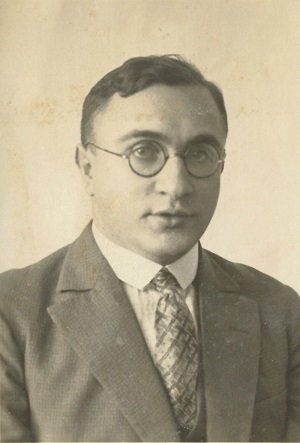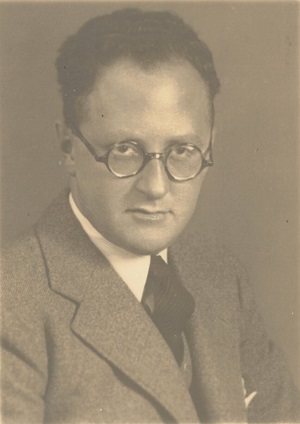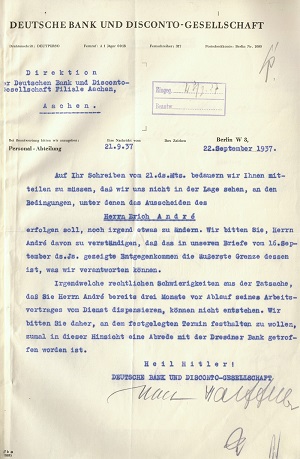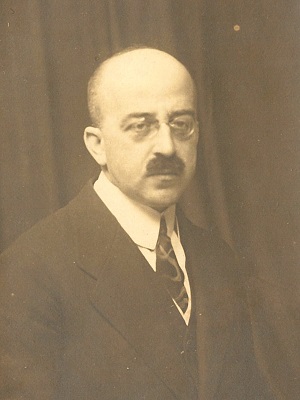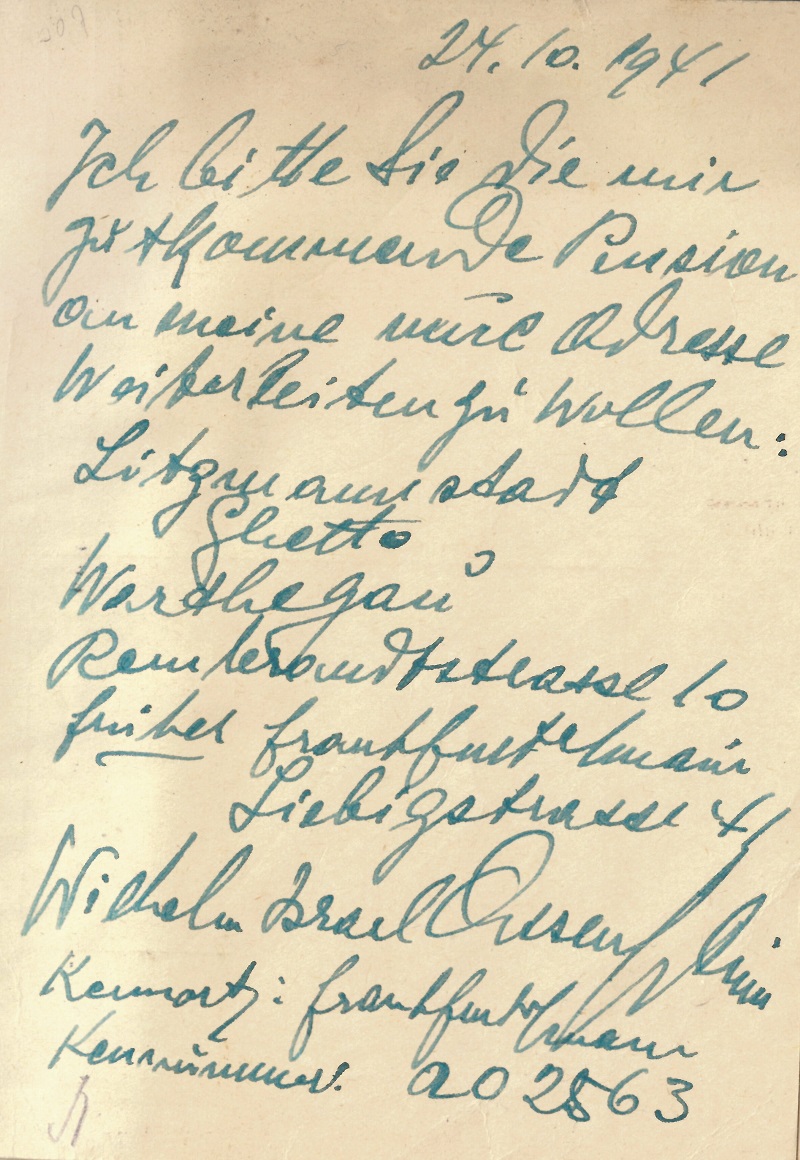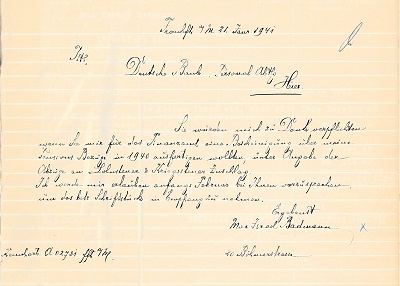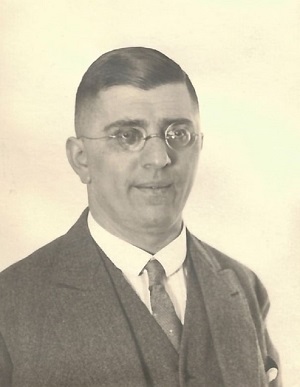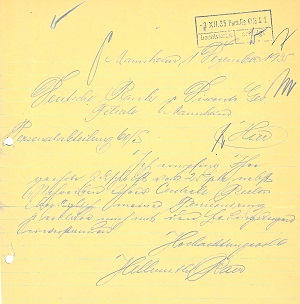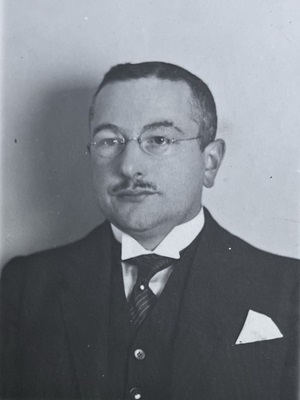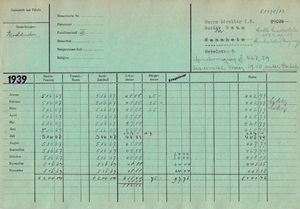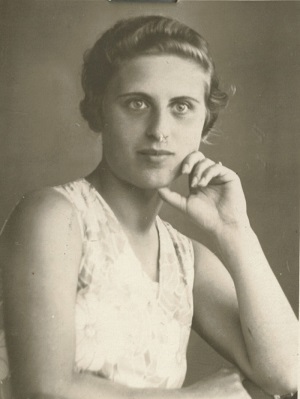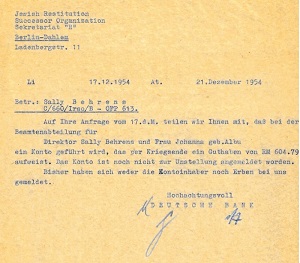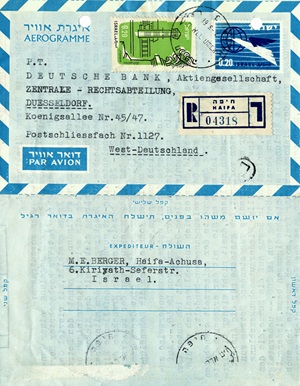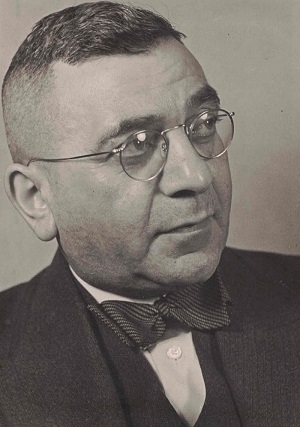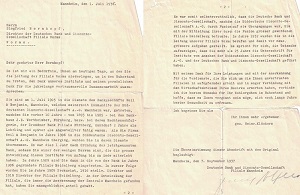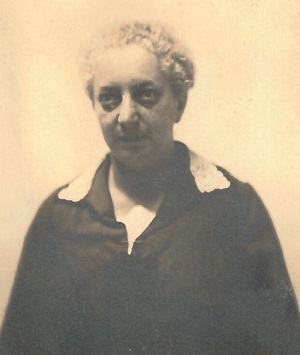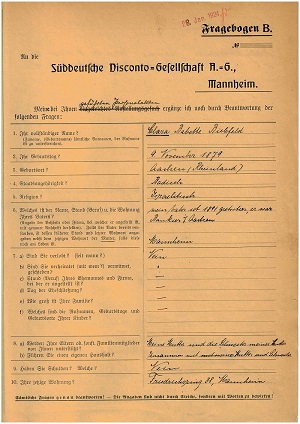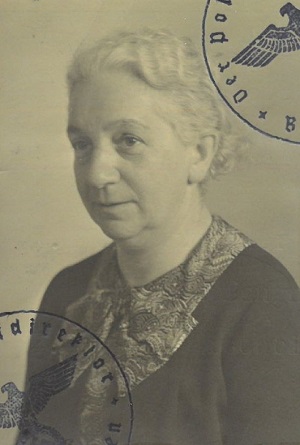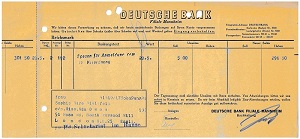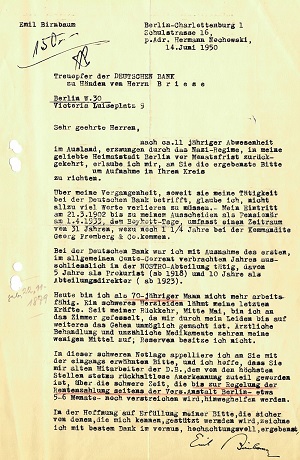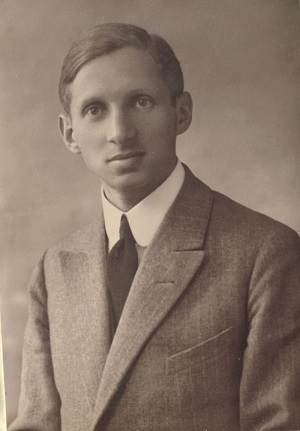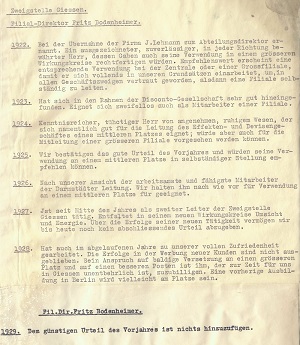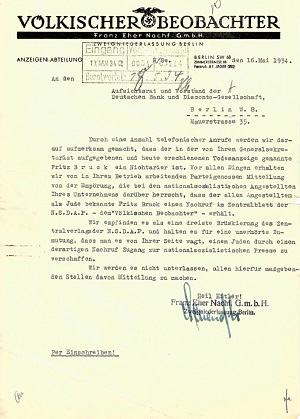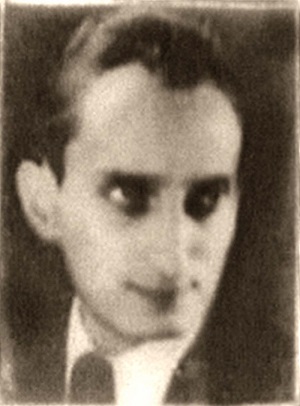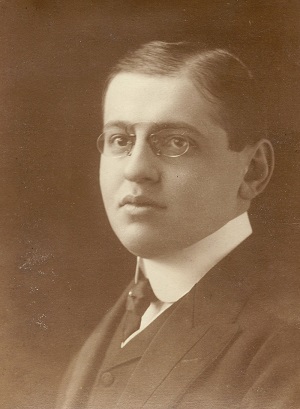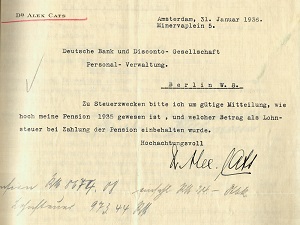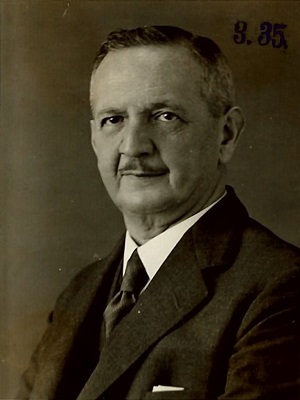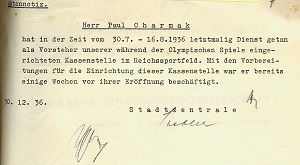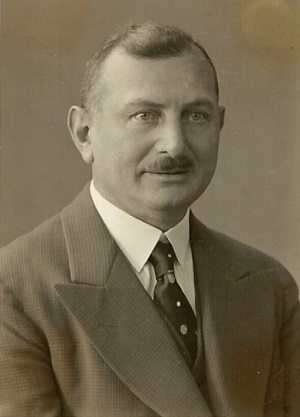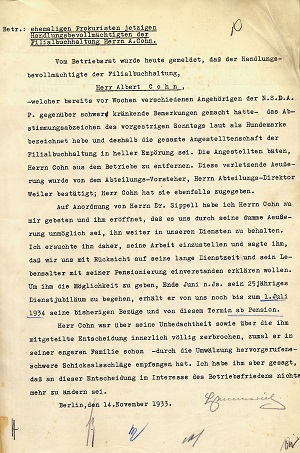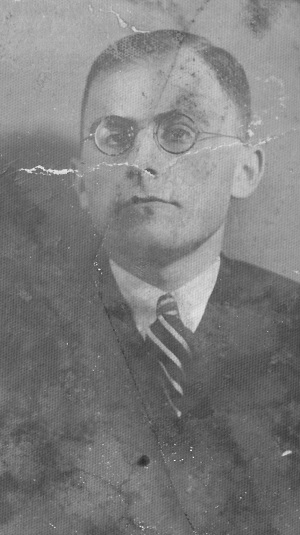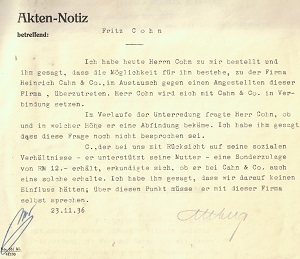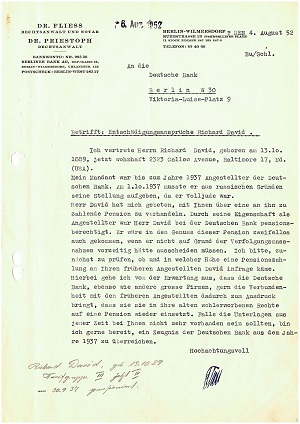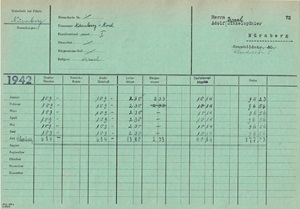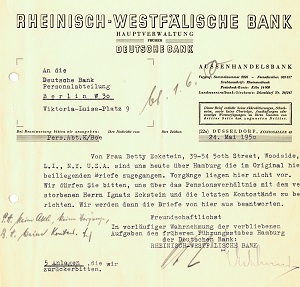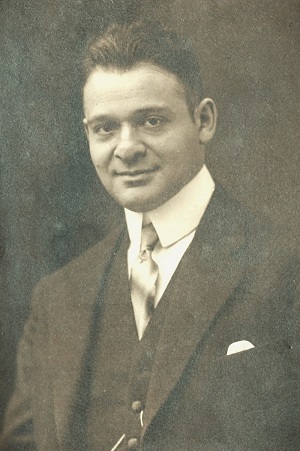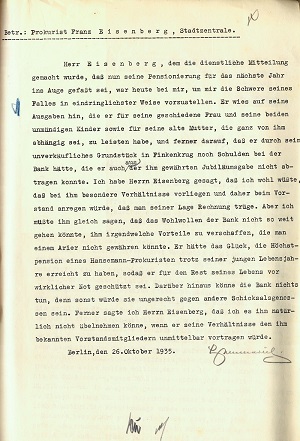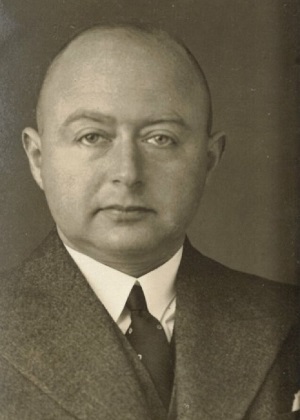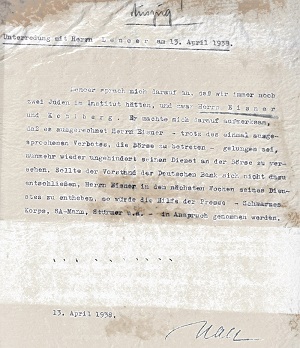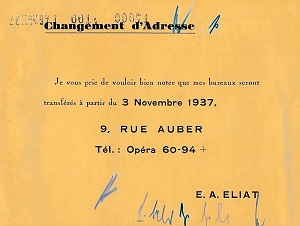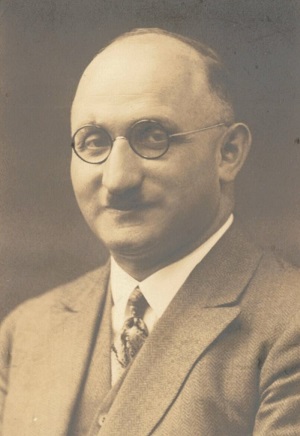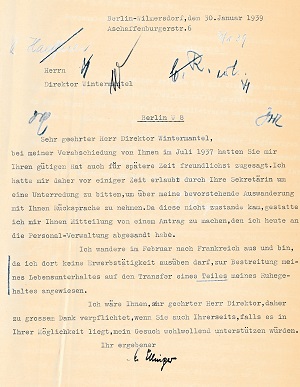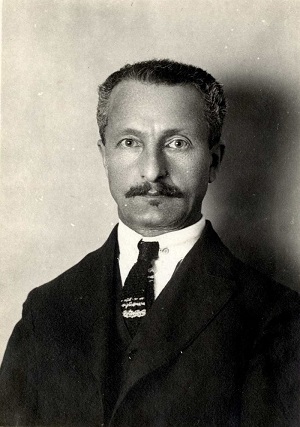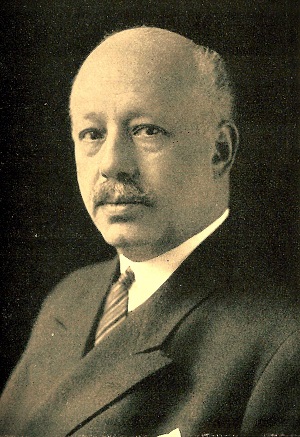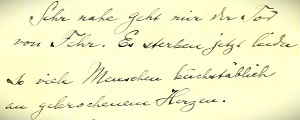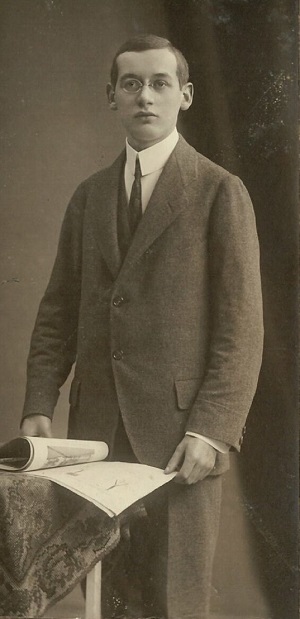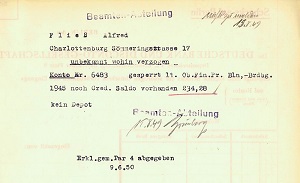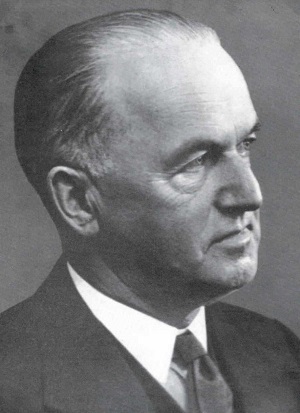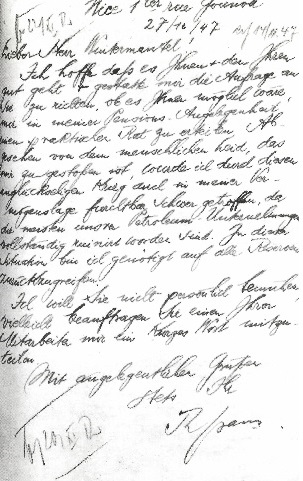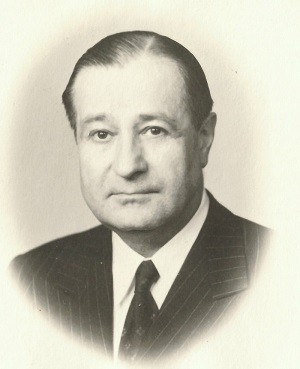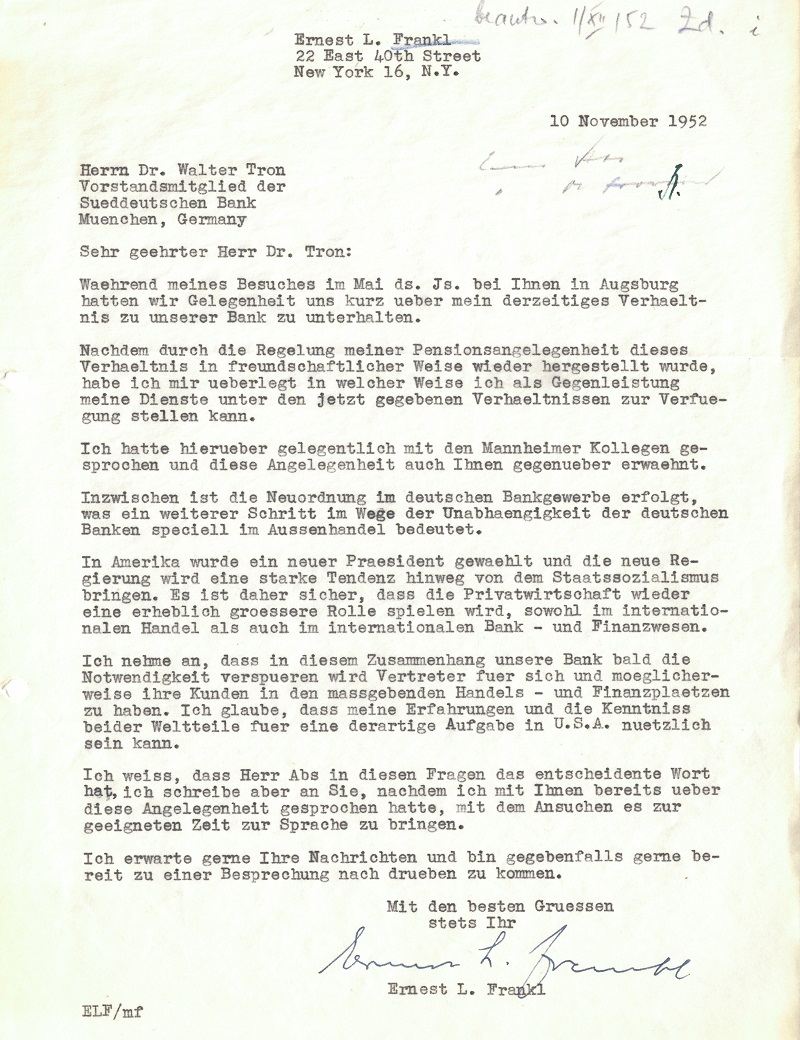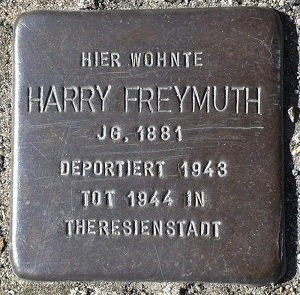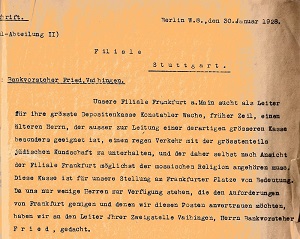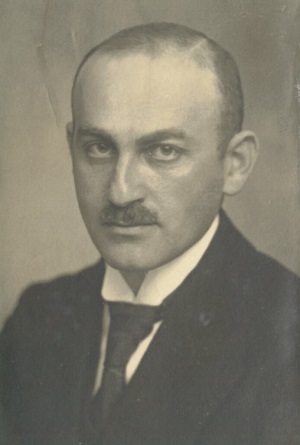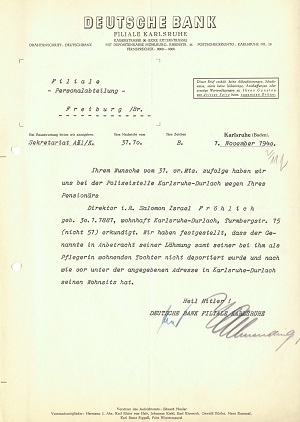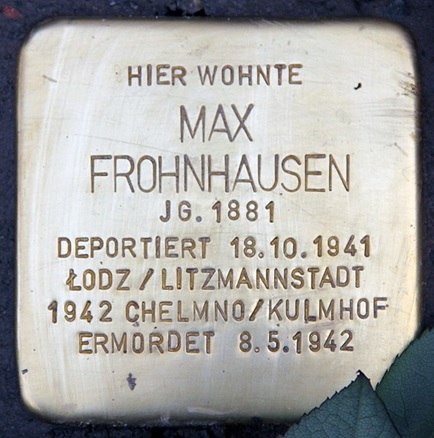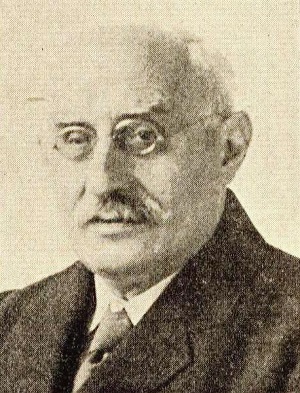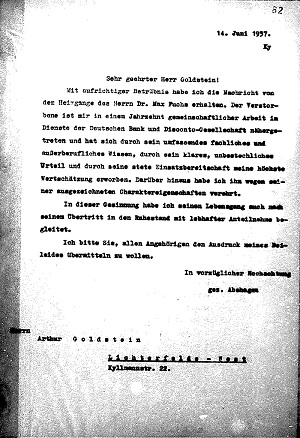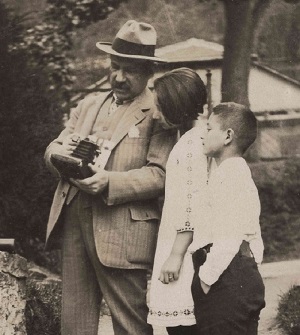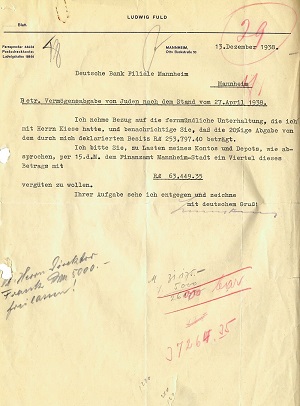Show content of Alexander, Georg
| first name(s), surname: | Georg Alexander | ||
| day of birth: | 03.01.1906 | ||
| birthplace: | Berlin | ||
| day of death: | 02.01.1944 | ||
| place of death: | Auschwitz | ||
| photo: |
|
||
| life: |
Georg Alexander was born in Berlin in 1906, the son of Wilhelm Alexander (1877-1938), a plumber, and Gertrud (Trude) Alexander (1881-1940). He attended the Werner Siemens middle school up to 9th grade and began a two-and-a-half-year banking apprenticeship at Deutsche Bank in Berlin in April 1923. After completing his apprenticeship, he worked for Deutsche Bank in a Berlin subbranch, the Central Transfers department and the Bills of Exchange department from 1925 to 1929. Deutsche Bank described him as an "extremely capable, conscientious worker who combines a quick grasp of things with brisk activity". In May 1929, Georg Alexander went to the Frankfurt am Main branch of Deutsche Bank as an "exchange employee" for a little over a year. He then returned to the Berlin head office, where he was dismissed at the end of 1936 because of his Jewish ancestry. Sources on his last years at the bank have not survived, nothing is it known about any subsequent activity. |
||
| joined Deutsche Bank (or precursor): | 03.04.1923 | ||
| end of employment: | 31.12.1936 | ||
| career: | 03.04.1923 - 30.09.1925 Deutsche Bank Berlin (apprenticeship) 01.10.1925 - 30.04.1929 Deutsche Bank Berlin 01.05.1929 - 31.10.1930 Deutsche Bank Frankfurt am Main branch 01.11.1930 - 31.12.1936 Deutsche Bank Berlin |
||
| last known address: | Berlin-Charlottenburg, Knesebeckstraße 75, rear house, 3rd floor | ||
| transports: | 12.03.1943 from Berlin to Auschwitz | ||
| archival sources: | HADB, P3/A68 HADB, B381 HADB, DB(alt)/375 |
||
| literature: | Manfred Mosche Gerson: Ein Leben im 20. Jahrhundert. Von Westpreußen über Berlin und Hannover durch Amerika, NS-Deutschland und Lettland nach Israel 1906-1982. Edited by Erhard Roy Wiehn, Konstanz: Hartung-Gorre Verlag 2002 | ||
| links: |
https://yvng.yadvashem.org/nameDetails.html?language=de&itemId=11457333&ind=1 https://collections.arolsen-archives.org/de/document/11220524 https://www.bundesarchiv.de/gedenkbuch/de1052811 https://www.stolpersteine-berlin.de/de/knesebeckstrasse/75/margarete-gerson https://www.geni.com/people/Georg-Alexander/6000000089452014031 |
Show content of André, Erich
| first name(s), surname: | Erich André |
| day of birth: | 27.07.1904 |
| birthplace: | Aix-la-Chapelle (Aachen) |
| day of death: | 04.12.1942 |
| place of death: | Auschwitz |
| photo / document: | |
| life: |
The son of Norbert André, a master butcher, finished school with an upper secondary school leaving certificate and then began an apprenticeship at the Deutsche Bank Aachen branch, which employed him permanently after he had completed his education. Following his forced departure from the bank at the end of 1937, he emigrated in 1939, first to Antwerp and later to France, where he was sent to the Saint-Cyprien internment camp in May 1940. From there he was taken to the Camp de Rivesaltes in 1942 and a little later to the Drancy collection camp, from where he was deported to Auschwitz in November 1942 and murdered a month later. |
| joined Deutsche Bank (or precursor): | 01.07.1921 |
| end of employment: | 31.12.1937 |
| career: | 01.07.1921 - 30.09.1923 Deutsche Bank Filiale Aachen (apprenticeship) 01.10.1923 - 31.12.1937 Deutsche Bank Aachen branch (current account department) |
| last known address: | Aachen, Thomashofstraße 17, "Stolperstein" (literally “stumbling stone or block”, metal cobblestone commemorating an individual victim of Nazism) laid on 6 February 2019 on the initiative of "Interessengemeinschaft der Alemannia Fans und Fan Club e.V." in cooperation with "TSV Alemannia Aachen" |
| transports: | 04.11.1942 from Drancy (France) to Auschwitz |
| archival sources: | HADB, F056/0006 |
| literature: | Harold James, The Deutsche Bank and the Economic War Against the Jews, p. 111f. |
| links: |
http://www.wgdv.de/stolpersteine/personenverzeichnis/171-andr%C3%A9,-erich-daniel http://www.familienbuch-euregio.de/genius/?person=441035 https://www.wikiwand.com/de/Liste_der_Stolpersteine_in_Aachen |
Show content of Assenheim, Wilhelm
| first name(s), surname: | Wilhelm Assenheim |
| day of birth: | 27.05.1878 |
| birthplace: | Offenbach |
| day of death: | 31.03.1942 |
| place of death: | Litzmannstadt (Lodz) |
| document: | |
| life: |
Wilhelm Assenheim completed a banking apprenticeship and spent his early professional years at the Jewish bank Siegmund Merzbach in his hometown Offenbach. He then moved to private banking house Baruch Bonn in neighbouring Frankfurt. In 1908, Assenheim joined the Frankfurt branch of Pfälzische Bank, which Deutsche Bank acquired in 1922. At the end of 1933, shortly after his 25th work anniversary (including his time at the predecessor institute Pfälzische Bank), Wilhelm Assenheim was forced into early retirement at the age of 55 because of his Jewish origin. Assenheim held account authorization for his former superior, the branch manager Eduard Rothschild, who was also Jewish, after Rothschild emigrated. From a special account, he transferred monthly support payments to Rothschild's relatives who remained in Germany until September 1941. |
| joined Deutsche Bank (or precursor): | 01.07.1908 (Pfälzische Bank) |
| end of employment: | retired on 31.12.1933 |
| career: |
01.04.1894 - 31.03.1896 S. Merzbach, Offenbach (apprenticeship) |
| last known address: | Frankfurt am Main, Liebigstrasse 41, "Stolperstein" (literally “stumbling stone or block”, metal cobblestone commemorating an individual victim of Nazism) laid on 29 October 2025 on the initiative of Deutsche Bank |
| transports: | 19.10.1941 from Frankfurt am Main to Litzmannstadt (Lodz) |
| archival sources: | HADB, P3/A144; HADB, P3/A180 |
| literature: | Harold James, The Nazi Dictatorship and the Deutsche Bank, Cambridge, 2004, p. 51 |
| links: |
https://www.bundesarchiv.de/gedenkbuch/de833974 https://www.statistik-des-holocaust.de/OT411019-1.jpg https://yvng.yadvashem.org/nameDetails.html?language=en&itemId=11459866&ind=1 |
Show content of Badmann, Max
| first name(s), surname: | Max Badmann |
| day of birth: | 01.11.1866 |
| birthplace: | Frankfurt am Main |
| day of death: | 25.05.1942 |
| place of death: | Litzmannstadt (Lodz) |
| document: | |
| life: | Max Badmann completed an apprenticeship in 1883 at the E. Ladenburg banking house, which had been established in Frankfurt since 1848. Its headquarters were located at Junghofstraße 14. In 1930, the bank was merged into the neighbouring Deutsche Bank Frankfurt branch. Badmann retired in the same year. He last worked as an authorised signatory for the bank He received a monthly pension of RM 400. He had been married to Minnie Hall (born 10.09.1875 - unknown date of death) since 1908. His wife ran the Anna Höchberg shop for ladies' fashions at Kaiserstrasse 15 in Frankfurt until the end of 1938. The couple lived at Böhmerstrasse 20 in Frankfurt’s Westend district from 1934 to 1941. Their son, Julius, (born 21.12.1908) immigrated to Brazil in 1939. At the end of 1941, Max Badmann and his wife were deported to the Litzmannstadt (Lodz) ghetto, where he died a few months later. Deutsche Bank stopped pension payments at the moment of deportation, as demanded by National Socialist laws. |
| joined Deutsche Bank (or precursor): | 25.02.1905 (E. Ladenburg) |
| end of employment: | 01.10.1930 |
| career: | 1883 - 1930 E. Ladenburg Frankfurt a. M. (1930 takeover of Deutsche Bank) |
| last known addresses: | Frankfurt am Main, until 1933 Oberlindau 98; 1934 - 1941 Böhmerstrasse 20, "Stolperstein" (literally “stumbling stone or block”, metal cobblestone commemorating an individual victim of Nazism) laid in September 2021 on the initiative of Deutsche Bank; 1941 until deportation Mainzer Landstrasse 32 |
| transports: | 19.10.1941 from Frankfurt am Main to Litzmannstadt (Lodz) |
| archival sources: | HADB, P03/B0023 |
| links: | https://www.geni.com/people/Max-Badmann/6000000064495203004 https://yvng.yadvashem.org/nameDetails.html?language=en&itemId=11460858&ind=1 |
Show content of Baer, Hellmuth
| first name(s), surname: | Hellmuth Baer |
| day of birth: | 18.06.1890 |
| birthplace: | Mannheim |
| day of death: | 16.05.1946 |
| place of death: | Shanghai |
| photo / document: | |
| life: | Hellmuth Baer came from a Jewish family from Mannheim. His parents were Max and Henrietta Baer. Hellmuth Baer attended the secondary school (Oberrealschule and Reformschule) until 11th grade (Obersekunda). At the end of 1907, he began a banking apprenticeship at Süddeutsche Disconto-Gesellschaft in his hometown. After his apprenticeship, he worked in several departments of the bank and became a specialist in brokerage. In 1918, he was granted limited power of representation, and in 1920, power of attorney. He eventually headed the securities correspondence and subscription rights department. When Süddeutsche Disconto-Gesellschaft merged into the new Deutsche Bank und Disconto-Gesellschaft in October 1929, Hellmuth Baer was taken on as a holder of power of attorney at its Mannheim branch. Because of his Jewish heritage, he was prematurely retired in the autumn of 1936, at the age of only 46. He received transitional support from the bank of 2400 Reichsmark and a monthly pension of 433.33 Reichsmark, which was paid until November 1941. Hellmuth Baer married Hedwig née Wolf (6 April 1902 in Rastatt - 2 September 1942 in Auschwitz) on 11 March 1923. The couple had two children: Max (22 January 1924 in Mannheim - 29 October 1942 in the North Atlantic on board the MV Abosso) and Lore, married Kirchheimer (16 October 1928 in Mannheim - 2 November 2019 in Chicago). On 10 November 1938, the day after "Kristallnacht", according to his daughter's later account, SS men stormed the apartment at Richard-Wagner-Strasse 53 in Mannheim, smashed the furniture and dragged Hellmuth Baer to the Dachau concentration camp (prisoner number 20370). He was released at the end of December 1938. His wife had meanwhile taken steps to emigrate the family. Hellmuth Baer was able to leave for Shanghai soon after his release. Their daughter Lore came to England on a Kindertransport in May 1939. Their son Max was already in Italy, where he was training as a chef. Hedwig Baer did not manage to escape. She remained in Mannheim and, like many Baden and Saar Palatinate Jews, was deported to the Gurs internment camp in southwestern France on 22 October 1940. From there she was later taken to the Drancy assembly camp near Paris and deported to Auschwitz on 10 August 1942, where she was murdered on 2 September 1942. Her husband died in Shanghai in 1946. Their son Max, who had visited his sister in England in 1940, was arrested as an enemy alien and taken to Australia. In the autumn of 1942, when he tried to return to England to serve in the British Army, his ship was sunk by a German submarine in the North Atlantic. Lore moved to Chicago in 1946, where she married a Holocaust survivor from Vienna. She died in Chicago in 2019. |
| joined Deutsche Bank (or precursor): | 01.11.1907 (Süddeutsche Disconto-Gesellschaft, Mannheim) |
| end of employment: | 01.10.1936 |
| career: | 01.11.1907 - 29.10.1929 Süddeutsche Disconto-Gesellschaft, Mannheim (apprenticeship, assistent manager 1918, holder of power of attorney 1920, most recently head of securities correspondence and subscription rights) 30.10.1929 - 30.09.1936 Deutsche Bank und Disconto-Gesellschaft Mannheim branch (holder of power of attorney) |
| last known address: | Mannheim, Richard-Wagner-Strasse 53 |
| emigration: | to Shanghai in 1939 |
| archival sources: | HADB, P33/B0035; HADB, F028/0687 |
| links: |
https://portal.ehri-project.eu/units/us-005578-irn107296 |
Show content of Baum, Gustav
| first name(s), surname: | Gustav Baum | ||||
| day of birth: | 16.02.1881 | ||||
| birthplace: | Hassfurt | ||||
| day of death: | 28.05.1951 | ||||
| place of death: | unknown | ||||
| photo / document: |
|
||||
| life: | Gustav Baum came from a Jewish family from Hassfurt in northern Bavaria, where there was a larger rural Jewish community. Nothing is known about his education and career. He can be proven to have been an assistent manager of Süddeutsche Bank in Mannheim since at least 1909. Süddeutsche Bank was founded through the conversion of the private bank Goldmann & Kuhn in 1896. In 1911, Süddeutsche Bank was taken over by Pfälzische Bank in Ludwigshafen, but continued under its own name as a "division of Pfälzische Bank". Currency speculations by a deputy director of the Munich branch of Pfälzische Bank led to such large losses in early 1922 that Pfälzische Bank was taken over by Rheinische Creditbank in Mannheim. Gustav Baum may have remained with a new Pfälzische Bank founded as a subsidiary for another four years before joining Rheinische Creditbank in Mannheim as a department manager in early 1926. When Rheinische Creditbank merged into the new Deutsche Bank und Disconto-Gesellschaft in the autumn of 1929, Gustav Baum was able to continue his work at its Mannheim branch. Because of his Jewish origin, he was prematurely retired in mid-1937. He received a transitional allowance of 3100 Reichsmark and a monthly pension of 516.67 Reichsmark, which was paid until November 1941. Gustav Baum was married to Clementine née Goldmann (5 October 1893 in Zeil am Main (near Hassfurt) - 10 June 1969). The couple had a daughter, Ilse married Oppenheimer. In 1939, the family managed to escape to Uruguay. |
||||
| joined Deutsche Bank (or precursor): | 1911 (Pfälzische Bank Mannheim branch) | ||||
| end of employment: | 30.06.1937 | ||||
| career: | from 1909 at the latest - 1911 Süddeutsche Bank, Mannheim (assistant manager) 1911 - 1922 Süddeutsche Bank, Department of Pfälzische Bank, Mannheim (holder of power of attorney from 1914 at the latest, deputy director from 1920 at the latest) 1922 - 31.12.1925 Pfälzische Bank, Mannheim (subsidiary of Rheinische Creditbank) 01.01.1926 - 29.10.1929 Rheinische Creditbank (department manager) 30.10.1929 - 30.06.1937 Deutsche Bank und Disconto-Gesellschaft Mannheim branch (department manager) |
||||
| last known address: | Mannheim, Hebelstrasse 5; Montevideo, Calle Ciudadela 1174, ap. 13 | ||||
| emigration: | to Montevideo (Uruguary in 1939) | ||||
| archival sources: | HADB, B381; HADB, K04/025; HADB, F028/0687 | ||||
| links: |
http://www.landesarchiv-bw.de/plink/?f=4-1621328 |
Show content of Baum, Hanni
Show content of Behrens, Sally
| first name(s), surname: | Sally Behrens | ||
| day of birth: | 29.12.1868 | ||
| birthplace: | Rethem an der Aller | ||
| day of death: | 09.04.1943 (declared dead) | ||
| place of death: | Sobibor | ||
| document: |
|
||
| life: |
Sally Behrens was born in 1868 in Rethem an der Aller, which at that time was located in the Prussian province of Hanover. His parents were Behrens [sic] Behrens and Johanna née Krämer. Nothing is known about his school and professional education. He is first documented as holder of power of attorney at the Berlin head office of Deutsche Bank in 1900, but he probably joined the bank much earlier. In 1919 he was appointed department director and in 1922 deputy director of the Berlin head office. Finally, he headed the stock exchange correspondence office. In 1925 he was retired. |
||
| joined Deutsche Bank (or precursor): | unknown | ||
| end of employment: | 1925 | ||
| career: |
09.04.1900 - 1918 Deutsche Bank head office (holder of power of attorney) |
||
| last known address: | Berlin-Wilmersdorf, Hohenzollerndamm 35; Amsterdam Zuid, Noorder Amstellaan, 35 huis | ||
| emigration: | on 15.03.1939 to the Netherlands | ||
| transports: | on 04.04.1943 imprisonment in the Westerbork transit camp; on 06.04.1943 deportation to the Sobibor extermination camp | ||
| archival sources: | HADB, B377; HADB, DB(alt)/0963; HADB, DB(alt)/0390 | ||
| links: |
https://www.bundesarchiv.de/gedenkbuch/de1043124 https://www.joodsmonument.nl/en/page/492397/sally-behrens-and-his-family https://www.geni.com/people/Sally-Behrens/6000000052221475836 |
Show content of Berger, Maurycy
| first name(s), surname: | Maurycy (later Moscheh Efraim) Berger | ||
| day of birth: | 1892 | ||
| birthplace: | unknown | ||
| day of death: | 1975 | ||
| place of death: | Haifa | ||
| document: |
|
||
| life: | The parents of Maurycy (later Moscheh Efraim) Berger were Leon Abraham Leib Berger and Baila Rachel, née Baum. He studied law and graduated with a Master's degree. From July 1923, Berger worked for the Katowice branch of Disconto-Gesellschaft. The Upper Silesian industrial city had belonged to Poland since 1922. In addition to Disconto-Gesellschaft, Deutsche Bank and Dresdner Bank also had branches there. When Deutsche Bank and Disconto-Gesellschaft merged in October 1929 and consolidated their offices in Katowice, Berger remained with the branch. He headed the legal and tax department as a non-tariff employee. While all Jewish employees in Germany had to leave the bank by 1938 at the latest, Berger worked for the Katowice branch until the outbreak of war on 1 September 1939. As a reserve officer, he was drafted into the Polish army and became a German prisoner of war. His wife Tauba Berger and children Sara Lea and Riwka Berger remained in Katowice. They ended up in the Warsaw Ghetto, where they died. Berger emigrated to Israel in 1949. He lived in Haifa and worked there until the end of 1960 for a waterworks on Mount Carmel. He died in Haifa in 1975. In his second marriage, Berger was married to Johanna (Hanni), née Danziger (26 October 1897 in Berlin – 12 October 1974 in Cologne). |
||
| joined Deutsche Bank (or precursor): | July 1923 (Disconto-Gesellschaft Katowice branch) | ||
| end of employment: | 01.09.1939 | ||
| career: | July 1923 - 29.10.1929 Disconto-Gesellschaft Katowice branch 30.10.1929 - 06.10.1937 Deutsche Bank und Disconto-Gesellschaft Katowice branch 07.10.1937 - 01.09.1939 Deutsche Bank Katowice branch (non-tariff employee) |
||
| last known adress: | Haifa, Israel | ||
| emigration: | to Israel in 1949 | ||
| archival sources: | HADB, B0381; HADB, ZA40/0322 | ||
| links: |
https://www.geni.com/people/Mosche-Efraim-Berger/6000000180522377862 |
Show content of Berne, Jacob
| first name(s), surname: | Jacob Berne |
| day of birth: | 01.03.1879 |
| birthplace: | Witkowo |
| year of death: | 29.02.1944 |
| place of death: | London |
| life: | Jacob Berne came from Witkowo in the Prussian province of Posen. He studied law and received a doctorate in law. In 1905 he was appointed as a court assessor and in the same year settled in Berlin as a lawyer. His clients included the CEO of Deutsche Bank, Arthur von Gwinner. In April 1916 he joined Deutsche Bank in Berlin as a deputy director. There he was employed in the so-called secretariat, the capital market and consortium department, where he looked after "real estate matters". He was involved in an advisory capacity in the merger of Philipp Holzmann AG with the Internationale Baugesellschaft in 1917. In September 1927 Berne was appointed deputy member of the Management Board of Deutsche Bank. He retained this position even after the merger of Deutsche Bank with Disconto-Gesellschaft in October 1929. At the end of 1931, due to the banking crisis and to simplify management, the position of deputy board member was abolished. The previous members of this group - including Berne - had been entitled "Directors of the Bank" since 1932 and had general power of attorney. Berne held numerous supervisory board mandates for the bank: AG für Baubeteiligungen und Baufinanzierungen (chairman), Finanzierungsgesellschaft für Landkraftmaschinen AG (member), Maschinenfabrik der R. Wolf AG (member), Tempelhofer Feld AG für Grundstücksverwertung (member), Varziner Papiermühle (member). At the end of 1932, Berne was probably forced into retirement and worked as a lawyer in Berlin again until his emigration. In 1938, his office was located at Herwarthstrasse 4 in Berlin. With his wife Melanie Berne née Cahn (born 6 March 1892) he emigrated to London in 1939, where he died in 1944. |
| joined Deutsche Bank: | April 1916 (Deutsche Bank Berlin head office) |
| end of employment: | retired by the end of 1932 |
| career: | 1905 - 1916 lawyer in Berlin April 1916 - 22.09.1927 Deutsche Bank Berlin head office, secretariat (deputy director) 22.09.1927 - 29.10.1929 Deutsche Bank Berlin head office (deputy member of the management board) 29.10.1929 - end of 1932 Deutsche Bank and Disconto-Gesellschaft Berlin (deputy member of the management board, since 1931 director of the entire bank) |
| last known adress: | Berlin, Admiral von Schröder-Strasse 29 (Kaiserin-Augusta-Strasse and a part of Königin-Augusta-Strasse were renamed to Admiral-von-Schröder-Strasse on 7 December 1933). With effect from 31 July 1947, the renaming to Köbisstraße was officially confirmed.) |
| emigration: | 1939 to the United Kingdom |
| archival sources: | HADB, SG18/11 |
| literature: | Reichshandbuch der Deutschen Gesellschaft. Das Handbuch der Persönlichkeiten in Wort und Bild, vol. 1, Berlin 1931, p. 118 |
| links: |
Show content of Bernkopf, Siegfried
| first name(s), surname: | Siegfried (Fred S.) Bernkopf | ||||
| day of birth: | 06.06.1879 | ||||
| birthplace: | Forth (today part of Eckental, Erlangen-Höchstadt district) | ||||
| day of death: | 03.09.1954 | ||||
| place of death: | Denver, Colorado | ||||
| photo / document: |
|
||||
| life: | Siegfried Bernkopf was born in 1879 as the son of the merchant Ignatz Bernkopf (1846-1885) and his wife Lina (Helena), née Priester, in Forth, a village about 20 kilometers east of Erlangen in Bavaria. He attended the humanistic high school probably in Nürnberg. Due to the early death of his father, he was unable to study for financial reasons. At the age of 16, in 1895, he began an apprenticeship at the Nuremberg bank J.E. Wertheimber, which he was able to continue when the bank was transformed into the Dresdner Bank Nuremberg branch in 1896. Bernkopf remained employed there as a clerk until 1905. In the middle of the same year, he joined the Mannheim bank Weil & Benjamin, which was merged into Süddeutsche Disconto-Gesellschaft in Mannheim, founded in 1905, just six months later. He worked for Süddeutsche Disconto-Gesellschaft in Mannheim until August 1909, before being transferred to its Heidelberg branch, where he was given power of attorney. In 1916 he was promoted to deputy director, and in 1918 he became director of the branch. When Süddeutsche Disconto-Gesellschaft became part of Deutsche Bank und Disconto-Gesellschaft in October 1929, Bernkopf remained director of its Heidelberg branch. In the spring of 1932 he was transferred to the neighboring Worms branch, where he also worked as one of two directors. The Bernkopf family lived in the house at Mozartstrasse 20, which belonged to Deutsche Bank und Disconto-Gesellschaft. Co-director in Worms was Rudolf Kröhler (1881-1946), who had been managing the branch since 1911. In the years between 1933 and 1936, Bernkopf was invited to lunch several times by Kröhler - a gesture towards his Jewish colleague that the Bernkopf family still gratefully remembers today. In 1919, Siegfried Bernkopf married Gertrude (Trude) Oppenheimer (born 23 March 1895 in Bruchsal, died 27 January 1993 in Simsbury, Hartford, Connecticut). Their son Walter was born on 27 July 1926 in Heidelberg Tand died on 24 March 2025 in Connecticut. In the course of 1933, Bernkopf lost his status as director of the Worms branch due to his Jewish ancestry. However, he continued to work in the background for Deutsche Bank und Disconto-Gesellschaft in Worms until his early retirement in 1936. The vacant director position was not filled until early 1936. On 15 June 1936, the Bernkopf family left Worms and moved to Cologne, where they lived in the Sülz district. Siegfried and Gertrude Bernkopf traveled to the US (Hamburg-New York 8-16 September 1937) for the first time in 1937. When entering the country they listed Blanche Bernkopf as a "friend". She was a cousin of Siegfried Bernkopf. This first trip to the US was probably to prepare for emigration. One year later Gertrude Bernkopf brought her twelve-year-old son Walter to the US alone (with the SS Statendam, Rotterdam-New York 20-28 August 1938). He joined relatives in a suburb of Boston, Massachusetts, who invited him to stay with them. At the end of 1939, Siegfried and Gertrude Bernkopf also managed to escape from Germany to Havana through a connection with a Deutsche Bank client who was a Cuban consul. From there they traveled on the SS Florida to Miami on 10/11 December 1939. Their furniture, paintings, and family documents remained in a storage facility in Belgium, where they disppeared after the German occupation of the country in May 1940. The family initially lived in New York, where Siegfried Bernkopf worked as a shoe salesman. The family later settled in Denver, Colorado. In 1945, Siegfried Bernkopf, who changed his first name to Fred S. in the US, received American citizenship. He died in Denver in 1954. |
||||
| joined Deutsche Bank (or precursor): | 01.07.1905 (Weil & Benjamin, Mannheim) | ||||
| end of employment: | 01.07.1936 retired | ||||
| career: |
1895 - 1896 private bank J.E. Wertheimber, Nuremberg (apprenticeship) |
||||
| last known address: | Cologne, Mommsenstrasse 4 | ||||
| emigration: | End of 1939 to Cuba, arrival in Miami, US, on 11.12.1939 | ||||
| archival sources: | HADB, P47/B0010 | ||||
| links: |
http://www.lorlebergplatz.de/juden_in_erlangen_II_A-E.pdf |
Show content of Bielefeld, Clara
| first name(s), surname: | Clara Bielefeld | ||||
| day of birth: | 09.11.1879 | ||||
| place of birth: | Aachen | ||||
| day of death: | 31.12.1945 (declared dead) | ||||
| place of death: | unknown | ||||
| photo / document: |
|
||||
| life: | Clara Bielefeld came from a Jewish family from Aachen. Her parents were the banker Joseph Bielefeld (died 1891) and his wife Helene née Abenheimer (died 23 September 1923). The couple had five children, including Lily (21 August 1878 in Aachen - 22 October 1940 in Baden-Baden) and Sophie (born 21 February 1888). After her father's death, Helene Bielefeld moved with her children to Mannheim. There, Clara Bielefeld first attended the higher girls' school and then the commercial school. From 1898, she worked in various Mannheim businesses before joining Süddeutsche Disconto-Gesellschaft in Mannheim in early 1907, where she was employed as a secretary and correspondent. When Süddeutsche Disconto-Gesellschaft merged into the new Deutsche Bank und Disconto-Gesellschaft in autumn 1929, Clara Bielefeld initially continued to work at its Mannheim branch. However, due to her poor health, she was granted early retirement at the end of 1929. Her monthly pension was 194.16 Reichsmark, from which she also supported her sister Lily. In 1937, Clara Bielefeld moved from Mannheim to Baden-Baden. She initially lived with her two sisters Lily and Sophie at Balzenbergstrasse 10, and from 1939 in an apartment at Fremersbergstrasse 41. Sophie Bielefeld managed to escape to England in June 1939. To avoid the impending deportation to Gurs on 22 October 1940, Clara and Lily Bielefeld attempted suicide. Lily died, Clara survived. She remained in Baden-Baden until she recovered. She gave up the five-room apartment she and her sisters had been living in and moved into a two-room apartment in the same building. On 26 April 1942, she was deported from Stuttgart to the Izbica Ghetto, southeast of Lublin. The location was a "transit ghetto" to the extermination camps, especially to Belzec and Sobibor. Where and when Clara Bielefeld was murdered is unknown; officially, the date of death was set as 31 December 1945. Immediately after her deportation, the contents of her apartment were publicly auctioned, including oil paintings, etchings and engravings, antique furniture and a library with classics and art books. |
||||
| joined Deutsche Bank (or precursor): | 01.02.1907 (Süddeutsche Disconto-Gesellschaft, Mannheim) | ||||
| end of employment: | 31.12.1929 | ||||
| career: |
01.11.1898 - 15.03.1901 Auskunftei Schimmelpfeng, Mannheim (shorthand typist) |
||||
| last known address: | Mannheim, Friedrichsring 38 (until 1937); Baden-Baden, Balzenbergstrasse 10 (1937-1939); Baden-Baden Fremersbergstrasse 41 (1939-1942), "Stolperstein" (literally “stumbling stone or block”, metal cobblestone commemorating an individual victim of Nazism) laid on 27 January 2009 | ||||
| transport: | from Stuttgart to Izbica Ghetto on 26 April 1942 | ||||
| archival sources: | HADB P33/B0005; HADB, F028/0687 | ||||
| links: |
Show content of Bielefeld, Sophie
| first name(s), surname: | Sophie Bielefeld (later Belfield) | ||||
| day of birth: | 21.02.1888 | ||||
| birthplace: | Aachen | ||||
| day of death: | unknown | ||||
| place of death: | unknown | ||||
| photo / document: |
|
||||
| life: | Sophie Bielefeld came from a Jewish family from Aachen. Her parents were the banker Joseph Bielefeld (died 1891) and his wife Helene née Abenheimer (died 23 September 1923). The couple had five children, including Lily (21 August 1878 in Aachen - 22 October 1940 in Baden-Baden) and Clara (9 November 1879 - 31 December 1945). After her father's death, Helene Bielefeld moved with her children to Mannheim. There, Sophie Bielefeld attended elementary school for four years and then graduated from a secondary school for girls. After leaving school, she worked as a secretary for the lawyers Dr. Rosenfeld and Pudel in Mannheim for 15 years. After that, she briefly worked for the company Hoffmann & Städen in Mannheim and AG für Trikotweberei in Ludwigshafen. In 1922, she was hired by Rheinische Creditbank in Mannheim as a secretary. When Rheinische Creditbank merged into the new Deutsche Bank und Disconto-Gesellschaft in autumn 1929, Sophie Bielefeld continued to work for its Mannheim branch. On 1 April 1937, she was forced into early retirement because of her Jewish heritage. On 23 March 1937, Sophie Bielefeld moved from Mannheim to Baden-Baden. She initially lived with her two older sisters Clara and Lilly at Balzenbergstrasse 10, and from 1939 in an apartment at Fremersbergstrasse 41. In spring 1939, she received entry permission from the British Home Office and emigrated to England on 9 June 1939, where she later lived in Purley in South London. |
||||
| joined Deutsche Bank (or precursor): | 1922 (Rheinische Creditbank, Mannheim) | ||||
| end of employment: | 01.04.1937 | ||||
| career: |
ca. 1905 - ca. 1920 Dr. Rosenfeld and Pudel, attorneys at law, Mannheim (Secretary) |
||||
| last known address: | Baden-Baden, Balzenbergstrasse 10 (1937-1939); Baden-Baden Fremersbergstrasse 41 (1939); 51 Ross Road, South Norwood Hill, London | ||||
| emigration: | to England on 9 June 1939 | ||||
| archival sources: | HADB, F019/0001; F028/0015; F028/0687 | ||||
| links: |
https://gedenkbuch.baden-baden.de/person/bielefeld-sophie/ http://www.landesarchiv-bw.de/plink/?f=5-684999 |
Show content of Birnbaum, Emil
| first name(s), surname: | Emil Birnbaum | ||
| day of birth: | 22.11.1879 | ||
| birthplace: | unknown | ||
| day of death: | 18.07.1950 | ||
| place of death: | Berlin (West) | ||
| document: |
|
||
| life: |
Emil Birnbaum spent almost his entire career at the Berlin headquarters of Deutsche Bank, which he joined in 1902 at the age of 23. After a brief stint in the Current Account Department, he moved to the Nostro Department in 1903, where he worked for 30 years - initially as an ordinary employee, from 1918 as a holder of power of attorney and from 1923 as department director. |
||
| joined Deutsche Bank (or precursor): | 21.03.1902 | ||
| end of employment: | 01.04.1933 (retired) | ||
| career: |
21.03.1902 - 1903 Deutsche Bank, Berlin Head Office, Current Account Department, employee |
||
| last known address: | Berlin-Schöneberg, Kufsteiner Strasse 10 | ||
| emigration: | August 1939 to Palestine | ||
| archival sources: | HADB, P02/B0383; Landesarchiv Berlin, B Rep. 025-06 Nr. 218/57 | ||
| link: |
https://www.geni.com/people/Erna-Birnbaum/6000000096168919930 |
||
Show content of Bodenheimer, Fritz
| first name(s), surname: | Fritz Bodenheimer | ||||
| day of birth: | 28.11.1893 | ||||
| birthplace: | Darmstadt | ||||
| day of death: | 20.11.1961 | ||||
| place of death: | Randallstown/Maryland, USA | ||||
| photo / document: |
|
||||
| life: |
Fritz Bodenheimer was the son of a Darmstadt merchant (co-owner of the firm H. Bodenheimer). After several positions in regional Hessian banks, Bodenheimer joined the Darmstadt branch of the Disconto-Gesellschaft in 1922 as deputy director. In 1927 he moved to the Giessen branch as director. He kept this position after the merger of Disconto-Gesellschaft with Deutsche Bank. In 1931 Bodenheimer left the bank at his own request to take up a director post at the Frankfurt branch of the auditing company “Deutsche Treuhand AG für Warenverkehr”. Married to Rosi Bender, the daughter of a stockbroker, in 1923, Fritz Bodenheimer immigrated to the United States with his family, presumably in 1938. |
||||
| joined Deutsche Bank (or precursor): | 01.01.1922 (Disconto-Gesellschaft) | ||||
| end of employment: | 31.03.1931 | ||||
| career: |
1910 - 1912 Isaac Fulda, Mainz (apprenticeship) |
||||
| last known address: | Frankfurt am Main, Wehrheimerstraße 3 | ||||
| emigration: | presumably 1938 to the United States | ||||
| archival sources: | HADB, P03/B0890 | ||||
| links: |
https://www.findagrave.com/memorial/35819162/fritz-bodenheimer |
Show content of Bruck, Fritz
| first name(s), surname: | Fritz Bruck | ||
| day of birth: | 02.06.1886 | ||
| birthplace: | Neisse (Upper Silesia) | ||
| day of death: | 15.05.1934 | ||
| place of death: | Berlin | ||
| document: |
|
||
| life: |
Fritz Bruck was born in Neisse, Upper Silesia, in 1886. His parents were the merchant Benno Benjamin Bruck (died before August 1901) and Anna, née Lazarus. There is no information about his schooling and education. From 1906 he worked for Nationalbank für Deutschland (which merged with Darmstädter Bank to form Danat Bank in 1922), most recently as a department director. In 1923 he became co-owner of the Berlin brokerage firm Alexander Löwenherz Nachf. In 1927 he joined the management board of Liquidationskasse, founded in 1925. At the beginning of 1929 he moved to the head office of Disconto-Gesellschaft as head of the stock exchange department. Even after the merger of Disconto-Gesellschaft with Deutsche Bank in October of the same year, Bruck retained his position as head of the stock exchange department. He held supervisory board mandates at Bank für Industriewerte and Lombardkasse. In August 1933 he wrote a report for the Central Association of German Banks and Bankers on "The Importance of Stock Exchange Organisation for the Functionality of the Securities Markets". Fritz Bruck died on 15 May 1934 after a long illness and was buried on the Jewish cemetery in Berlin-Weissensee. |
||
| joined Deutsche Bank (or precursor): | 1929 Disconto-Gesellschaft, Berlin head office | ||
| end of employment: | 15.05.1934 (deceased) | ||
| career: |
1906 - 1923 Nationalbank für Deutschland (from 1922 Danat-Bank), 1922 department manager |
||
| last known address: | Berlin-Dahlem, Miquelstrasse 88-90 | ||
| archival sources: | HADB, B0270, HADB, SG18/0011, HADB, P11439 | ||
| literature: | Berliner Adressbuch, 1934, vol. I., p. 293 | ||
| links: |
https://www.online-ofb.de/famreport.php?ofb=juden_nw&ID=I108777&lang=de https://www.filmschaffende-in-gross-glienicke.de/wp-content/uploads/2021/05/juedische_Familien-1.pdf (p.12-14) |
Show content of Carsch, Alexander
| first name(s), surname: | Alexander Carsch | ||
| day of birth: | 28.03.1913 | ||
| birthplace: | Berlin | ||
| day of death: | unknown | ||
| place of death: | Auschwitz | ||
| photo: |
|
||
| life: | Alexander Carsch was the son of the painter and graphic artist Leopold Carsch (9 August 1874 in Essen - 29 March 1943 in Theresienstadt). Leopold Carsch was married four times, to Toni, née Wronsky, Alice, née Borchardt, Lydia, née Voigt, and Ellen Waldeck, née Rosenberg. From his second marriage to Alice, née Borchardt (22 December 1882 in Berlin - 23 July 1972 in New York), came the twins Alexander and Leonore Carsch. The marriage to Alice was divorced in 1920. The twins stayed with their mother, who moved into an apartment at Georg-Wilhelmstrasse 5 in Berlin-Wilmersdorf after the separation. Alexander Carsch trained as a bank clerk. He probably joined Deutsche Bank und Disconto-Gesellschaft in Berlin around 1930. In 1936, he was among the bank's employees who were classified in pay group II. He was baptized Protestant and, like his sister, was considered half-Jewish according to the "Nuremberg Race Laws." Nevertheless, he was dismissed from Deutsche Bank und Disconto-Gesellschaft on 30 June 1937. Nothing is known about his further professional activity. On 28 June 1943, Alexander Carsch was deported to Auschwitz, where he was murdered. Leonore Carsch was sent to Ravensbrück concentration camp on 16 September 1943. She was liberated from the concentration camp in 1945. She emigrated to New York with her mother in 1947. Alice Carsch died in 1972, Leonore, married name Benestante, in 1976 in the US. Alexander's father, Leopold Carsch, was deported to Theresienstadt on 17 March 1943, where he died 12 days later. |
||
| joined Deutsche Bank (or precursor): | around 1930 | ||
| end of employment: | 30.06.1937 | ||
| career: | around 1930 - 30.06.1937 Deutsche Bank und Disconto-Gesellschaft, Berlin | ||
| last known address: | Berlin-Halensee, Georg-Wilhelm-Strasse 5, "Stolperstein" (literally “stumbling stone or block”, metal cobblestone commemorating an individual victim of Nazism) laid on 17 June 2007 | ||
| transport: | 28.06.1943 to Auschwitz | ||
| archival sources: | HADB, B381 | ||
| literature: | Gedenkbuch der jüdischen Opfer des Nationalsozialismus, Berlin 1995, p. 186. | ||
| links: |
https://www.bundesarchiv.de/gedenkbuch/de1029902 https://collections.yadvashem.org/en/names/14015972 https://www.stolpersteine-berlin.de/de/georg-wilhelm-str/5/alexander-carsch https://www.geni.com/people/Alexander-Carsch-twin/6000000034952697617 |
Show content of Cats, Alexander
| first name(s), surname: | Alexander Cats | ||||
| day of birth: | 05.06.1884 | ||||
| birthplace: | Lemberg (Lviv), Austria-Hungary (today Ukraine) | ||||
| day of death: | 30.10.1954 | ||||
| place of death: | Freeport Island, New York, United States | ||||
| photo / document: |
|
||||
| life: | Although Alexander Cats was born in Lemberg in 1884 as the son of the merchant Moses Moritz Cats and Sydonia Cats née Tenner, he had Dutch nationality. In Berlin he first attended the Falk-Realgymnasium and then moved to the Königliche Wilhelm-Gymnasium, where he graduated with A-levels. Afterwards he studied law and economics in Berlin, Freiburg and Munich. In July 1905 he received his doctorate in law at the university of Rostock. Due to his Dutch nationality, Cats was not admitted to the legal traineeship, which prevented him from pursuing a career in the judiciary. Instead, he chose banking as his field of activity. From 1905 to 1906 he worked as a trainee at the Berlin branch of the A. Schaaffhausen'sche Bankverein and then at the Berlin private bank Max Marens & Co. In 1909 he moved to Deutsche Bank, for which he worked in the stock exchange department at the Berlin Head Office until 1931, most recently in the rank of director. In 1919 he married Elly Marx, and their son Peter was born in 1920. The reason for his departure from Deutsche Bank and Disconto-Gesellschaft during the banking crisis of 1931 is unclear. The press reported on 6 November 1931 that the bank had dismissed its stock exchange director Cats because he withdrew his cash balance of over one hundred thousand Reichsmarks and invested some of it in foreign currencies shortly before the legally imposed bank holiday during the banking crisis in July 1931. As the Berlin tax authorities determined in November 1931, Cats had made speculative profits through an account held by N.V. Zeehandel en Transport Matschappij in Amsterdam at Deutsche Bank und Disconto-Gesellschaft, which he concealed in his income tax return and under-declared his assets. Cats left Germany in 1933 and lived in Switzerland for a few months before moving to Amsterdam. In 1940 he emigrated from Amsterdam to the US. The bank made pension payments until 31 March 1943. In 1946 he became an American citizen. Cats spent the last years of his life in Freeport Island, New York, where he died in 1954. |
||||
| joined Deutsche Bank (or precursor): | 15.07.1909 | ||||
| end of employment: | 31.12.1931 | ||||
| career: | 01.10.1905 - 30.09.1906 A. Schaaffhausen´scher Bankverein Berlin branch (trainee) 01.10.1906 - 1909 Max Marens & Co., Berlin (Juli 1907 assistant manager) 15.07.1909 - 29.10.1929 Deutsche Bank Berlin Head Office, stock exchange department (1916 holder of power of attorney; 1921 head of department; 1926 deputy director; 1929 director) 30.10.1929 - 31.12.1931 Deutsche Bank und Disconto-Gesellschaft Berlin Head Office, stock exchange department (director) |
||||
| last known address: | Berlin, Keithstrasse 20 | ||||
| emigration: | 1933 to Amsterdam, 1940 to the United States | ||||
| archival sources: | HADB, P02/C0018; HADB, B229 | ||||
| link: |
http://www.lorlebergplatz.de/juden_in_erlangen_II_I-L.pdf (p. 49) |
Show content of Charmak, Paul
| first name(s), surname: | Paul Charmak | ||||
| day of birth: | 27.06.1876 | ||||
| birthplace: | Inowrazlaw (Province of Posen) | ||||
| day of death: | 01.05.1950 | ||||
| place of death: | Westerland (Sylt) | ||||
| photo / document: |
|
||||
| life: |
Paul Charmak was born in the province of Posen as the son of the merchant Jacob Charmak (18 June 1836 - 5 February 1905) and his wife Franziska née Michel (12 January 1842 - 4 June 1904). Both parents were Jewish, but had their son baptized as a Protestant. He grew up in Berlin, where he attended the Askanische Gymnasium until the eighth year. |
||||
| joined Deutsche Bank (or precursor): | 01.07.1902 (Deutsche Bank London branch) | ||||
| end of employment: | retired on 31.12.1936 | ||||
| career: | October 1895 - October 1898 J. Brehm, bank and commission business, Berlin (apprenticeship) October 1898 - October 1899 J. Brehm, bank and commission business, Berlin (clerk) October 1899 - October 1900 military service in Koblenz 1900 - 1902 Chapman, Anthony & Co., London (clerk for German correspondence) 01.07.1902 - 06.10.1905 Deutsche Bank London branch, stock department (clerk) 07.10.1905 - 27.04.1921 Deutsche Bank Berlin, several sub-branches (clerk) 28.04.1921 - 31.12.1936 Deutsche Bank Berlin, city head office Department A (since 28.7.1924 "Oberbeamter" (senior employee), since 1.10.1929 head of Department A, since 13.12.1932 assistant manager) |
||||
| last known address: | Berlin-Schöneberg, Heylstrasse 5 | ||||
| archival sources: | HADB, P02/C0006 | ||||
| link: |
https://www.deutsche-digitale-bibliothek.de/item/T2BZNCYBC3CKMZQJSYSKBJ6NO75KUQZP https://www.geni.com/people/Jakob-Charmak/6000000144680780837 |
Show content of Cohn, Albert
| first name, surname: | Albert Cohn | ||||
| day of birth: | 19.09.1883 | ||||
| birthplace: | Rotenburg (Province of Hanover) | ||||
| day of death: | 07.09.1964 | ||||
| place of death: | Kiryat Tivon, Israel | ||||
| photo/document: |
|
||||
| life: |
Albert Cohn's father was the owner of the J.D. Cohn company in Rotenburg in the province of Hanover, which traded in manufactured goods and also offered banking services. Albert Cohn attended middle school in Rotenburg and then high school in Bremen, where he graduated in 1901 with a secondary school certificate. He completed a banking apprenticeship at M. Koppel & Co. in Emden, before joining the N. Blumenfeld bank in Osnabrück as a clerk. In 1905/06 he did his military service as a one-year volunteer. After this, he joined the Bielefeld lingerie manufacturers G. Posner as a clerk and travelling salesman. In 1909 he returned to banking and moved to Berlin to work for Disconto-Gesellschaft, one of the leading big banks at the time. He worked for several city branches before moving to the so-called calculation department of the Berlin main city branch.
On 12 May 1914, Albert Cohn married Margarete Marutzky (22 September 1884 - 31 August 1970). Their daughter Erika was born on 2 April 1915. During the entire First World War, he served in the military with the rank of non-commissioned officer. At the end of 1918, he returned to Disconto-Gesellschaft, which employed him in the correspondence department. In 1921, he became assistent manager, and in 1923, he was given power of attorney. Due to the oversupply of managers, Cohn was one of the employees who were demoted in October 1929 when Disconto-Gesellschaft merged with Deutsche Bank. Instead of being a holder of power of attorney, he was only an assistent manager. After the National Socialists came to power, Cohn was targeted by party members among the bank's employees, who denounced him for critical comments to the personnel department. When, on the day after the referendum on Germany's withdrawal from the League of Nations, he described the election badge with the inscription "Yes 12.11.1933" as a "dog tag", the works council, which was now dominated by the National Socialists, demanded his dismissal. "In the interest of good relations between employers and employees", Management Board member Karl Ernst Sippell, who was responsible for personnel issues, agreed to this demand. Cohn was granted leave of absence on 14 November 1933, while retaining his salary, and retired on 1 July 1934. The National Socialist works cell chairman Franz Hertel was triumphant: "His job was [...] filled again by a capable colleague, who in this case is an old National Socialist". In 1936, Cohn attempted to emigrate to the British Mandate of Palestine, which was successful at the end of December 1936. The destination was the village of Kfar Jehoschua near Haifa. Pension payments could still be made through the Bank of the Temple Society in Jaffa until the start of World War II. The monthly pension was then paid into a special account in the employee branch of Deutsche Bank, but on 11 October 1940, the Gestapo confiscated all of Cohn's accounts due to denaturalization proceedings that had been initiated against him. Pension payments were stopped at the same time. In the post-war period, a lengthy process of restitution and compensation began. Albert Cohn died in 1964 in Kiryat Tivon in Israel. |
||||
| joined Deutsche Bank (or precursor): | 21.06.1909 (Disconto-Gesellschaft Berlin city branch Königstrasse) | ||||
| end of employment: | retired on 01.07.1934 | ||||
| career: |
01.04.1901 - 10.09.1903 M. Koppel & Co., Emden (apprenticeship) |
||||
| last known address: | Berlin-Friedenau, Menzelstrasse 20 | ||||
| emigration: | 22.12.1936 to Palestine | ||||
| archival sources: | HADB, P02/C0032, P02/C0033 |
Show content of Cohn, Fritz
| first name(s), surname: | Fritz Cohn | ||||
| day of birth: | 25.04.1909 | ||||
| birthplace: | Kronach | ||||
| day of death: | 25.11.1941 | ||||
| place of death: | Kovno (Kaunas) Fort IX | ||||
| photo / document: |
|
||||
| life: |
The son of the merchant Leopold Cohn attended the Philanthropin in Frankfurt am Main. After completing his secondary education, he began a banking apprenticeship at the Frankfurt branch of Deutsche Bank in 1924. On 1 October 1926, he was taken on as an employee. He first worked in various positions in the department for private clients and from April 1934 in the securities department. At the end of 1936, he was offered by Deutsche Bank to join the private bank Heinrich Cahn & Co. in exchange for one of their employees. Cohn's Jewish descent played a decisive role in this. He switched to the "Jewish" bank, which in return gave a non-Jewish employee to Deutsche Bank. Cohn received three months' salary as severance pay. In the course of 1938, when it became clear that Cahn & Co. would have to cease business activities, Cohn planned to emigrate, but this did not happen. After the Pogrom Night, he was deported to the Buchenwald concentration camp on 12 November 1938 and released from there on 5 May 1939. He returned to Frankfurt, where he lived in a household with his mother Selma Cohn. He found employment with the Frankfurt Jewish Community. Fritz Cohn and his mother Selma Cohn were taken on a deportation train to the ghetto (and later concentration camp) in the Lithuanian city of Kaunas on 22 November 1941, together with almost 1,000 Jewish citizens of Frankfurt. The transport reached its destination on 25 November 1941. Fritz and Selma Cohn were murdered on the same day. |
||||
| joined Deutsche Bank (or precursor): | 01.04.1924 | ||||
| end of employment: | 31.12.1936 | ||||
| career: | 01.04.1924 - 31.12.1936 Deutsche Bank Frankfurt am Main branch; 01.01.1937 - 1938 Heinrich Cahn & Co., Frankfurt am Main |
||||
| last known address: | Frankfurt am Main, Kostheimer Str. 20 II (together with his mother Selma Cohn, née Weil) | ||||
| transport: | 22.11.1941 from Frankfurt am Main to Kovno (Kaunas) Fort IX | ||||
| archival sources: | HADB, P03/C0096 HHStA, 519/3 Nr. 1431 |
||||
| links: |
https://collections.arolsen-archives.org/de/search/person/5693084?s=5693084&t=0&p=0 |
Show content of David, Richard
| first name(s), surname: | Richard David | ||
| day of birth: | 13.10.1889 | ||
| birthplace: | Magdeburg | ||
| day of death: | 14.02.1970 | ||
| place of death: | Baltimore, Maryland | ||
| document: |
|
||
| life: |
Little is known about Richard David's life and career. He came from Magdeburg and joined Disconto-Gesellschaft in Berlin in 1909 at the age of 19, where he worked without interruption until the merger with Deutsche Bank in October 1929. After the merger, he continued to work for Deutsche Bank and Disconto-Gesellschaft until the end of 1937, from 1932 as an auditor and accountant in the auditing department at the Berlin head office. Due to his Jewish descent, he had to retire at the age of only 48 in autumn 1937. |
||
| joined Deutsche Bank (or precursor): | 01.07.1909 | ||
| end of employment: | 01.10.1937 (retired) | ||
| career: |
01.07.1909 - 29.10.1929 Disconto-Gesellschaft Berlin head office |
||
| last known address: | Berlin-Karlshorst, Treskowallee 71 | ||
| emigration: | in February 1939 to Shanghai, in 1947 to the United States | ||
| archival sources: | HADB, P02/D0067 | ||
| link: |
http://collection.mjhnyc.org/index.php?g=detail&object_id=5197 https://www.myheritage.de/names/johanne_david https://www.geni.com/people/Johanne-David/6000000008364196114 |
||
Show content of Dinkelspühler, Adolf
| first name(s), surname: | Adolf Dinkelspühler | ||
| day of birth: | 09.06.1861 | ||
| birthplace: | Fürth | ||
| day of death: | 22.09.1942 | ||
| place of death: | Theresienstadt | ||
| document: |
|
||
| life: |
Adolf Dinkelspühler was born in Fürth. He was the son of Josef Dinkelspühler and Sara née Weil. He attended the Realgymnasium (today's Willstätter-Gymnasium) and the Königliche Studienanstalt in Nuremberg. How he entered the banking industry is unknown. From 1905 at the latest, he worked as a holder of power of attorney at the Nuremberg branch of Pfälzische Bank. The branch was established in 1898 after the takeover of the private bank Bloch & Co. in Nuremberg. Dinkelspühler presumably worked there until the collapse of Pfälzische Bank in 1921/22. Pfälzische Bank, headquartered in Ludwigshafen, and its branches were subsequently taken over by Rheinische Creditbank and Deutsche Bank. It cannot be determined whether Dinkelspühler worked for either of these banks. Therefore, he was probably retired in 1922. His pension, which was paid until June 1942, amounted to 109 Reichsmark. |
||
| joined Deutsche Bank (or precursor): | unknown | ||
| end of employment: | ca. 1922 | ||
| career: |
from 1905 at the latest - approx. 1922 Pfälzische Bank Nuremberg branch (holder of power of attorney) |
||
| last known address: | Nuremberg, Brunhildstrasse 40; ab 1941 Nuremberg, Theodorstrasse 5, "Stolperstein" (literally “stumbling stone or block”, metal cobblestone commemorating an individual victim of Nazism) laid on 22.05.2004 | ||
| transport: | to Theresienstadt on 10.09.1942 | ||
| literature: | Theresienstädter Gedenkbuch. Die Opfer der Judentransporte aus Deutschland nach Theresienstadt 1942-1945, Prague 2000, p. 276. | ||
| archival sources: | HADB, F028/0687 | ||
| links: |
https://www.bundesarchiv.de/gedenkbuch/de852135 https://www.stolpersteine-nuernberg.de/adolf-dinkelspuehler/ https://juedisch-in-fuerth.repositorium.gf-franken.de/de/personen.html?permaLink=fue00148#ID_ |
Show content of Eckstein, Ignaz
| first name(s), surname: | Ignaz Eckstein | ||
| day of birth: | 24.06.1878 | ||
| birthplace: | Oberlauringen near Schweinfurt | ||
| day of death: | 29.09.1948 | ||
| place of death: | Queens, New York, United States | ||
| document: |
|
||
| life: |
Nothing is known about Ignaz Eckstein's youth or professional training. He only becomes biographically tangible in 1911 as an employee of the Jena branch of the Bank für Thüringen vormals B. M. Strupp AG, which had its head office in Meiningen. In Jena he later became holder of power of attorney and finally director. In 1925 Bank für Thüringen vormals B. M. Strupp AG was taken over by Disconto-Gesellschaft. and in 1929 Deutsche Bank merged with Disconto-Gesellschaft. After both mergers, Eckstein remained director of the Jena branch. |
||
| joined Deutsche Bank (or precursor): | 01.05.1911 (Bank für Thüringen vormals B. M. Strupp) | ||
| end of employment: | 31.12.1930 | ||
| career: |
01.05.1911 - 1925 Bank für Thüringen vormals B. M. Strupp AG Jena branch (not later than 1914 holder of power of attorney, not later than 1920 director) |
||
| last known address: | Jena, Teutonengasse 2 | ||
| emigration: | 27.06.1939 to New York, United States | ||
| archival sources: | HADB, P02/E0083; Thüringisches Hauptstaatsarchiv Weimar, Deutsche Bank Filiale Weimar, 33 | ||
| links: |
https://www.geni.com/people/Ignaz-Eckstein/6000000091158078311 |
Show content of Eisenberg, Franz
| first name(s), surname: | Franz Eisenberg | ||||
| day of birth: | 19.09.1887 | ||||
| birthplace: | Zittau | ||||
| day of death: | probably 1942 | ||||
| place of death: | La Paz, Bolivia | ||||
| photo / document: |
|
||||
| life: | Franz Eisenberg was born in Zittau, Saxony. He was the son of the factory owner Henry Eisenberg (died 1890). His mother Selma, née Strupp (9 December 1861 - 7 October 1942) came from a Meiningen merchant and banker family that had founded B. M. Strupp bank in 1740. In 1905, the bank was converted into the joint-stock company Bank für Thüringen, formerly B. M. Strupp, and in 1926, the bank and its branches were taken over by Disconto-Gesellschaft. After Henry Eisenberg's early death, his widow moved back to Meiningen, where Franz attended secondary school, graduating in 1904. He then completed a banking apprenticeship at Bank für Thüringen, formerly B. M. Strupp, where he worked until 1908. This was followed by stints at Mitteldeutsche Creditbank (which B. M. Strupp co-founded in 1856) and at the private bank J. Löwenberg in Berlin. On the recommendation of his uncle Gustav Strupp to the partners of Disconto-Gesellschaft Franz Urbig and Hermann Waller, Eisenberg joined the Berlin head office of Disconto-Gesellschaft in October 1910, where he initially worked in the securities department and from 1911 in the stock exchange department. After that, Eisenberg worked as a cashier in various Berlin city sub branches of Disconto-Gesellschaft until the end of 1918, interrupted by temporary garrison duty with the Berlin Guard Cuirassier Regiment, from which he was released in March 1916 following intervention by his employer in view of the acute shortage of workers during World War I. From the end of 1918 he worked first in the customer file department and then again for several years in the stock exchange department of the head office. In 1926 he was initially appointed deputy head, and at the end of 1927 he became head of the Berlin city sub branch Kantstrasse. In September 1928 he moved to the city head office of Disconto-Gesellschaft and was given power of attorney shortly afterwards. Even after the merger of Deutsche Bank and Disconto-Gesellschaft the following year, he remained in the city head office of the merged bank. In October 1935, a few weeks after his 25th anniversary of service, Franz Eisenberg was informed that he would be given early retirement at the end of 1936 "in consideration of the current general conditions". From 24 March 1936 he was on leave from service until his retirement. In 1920 Franz Eisenberg married Resi Schütte (born 23 December 1899), who was not of Jewish origin. The marriage, which ended in divorce in 1932, produced two children, Peter (born 10 May 1921) and Gisela (born 8 February 1923). When he was forced into early retirement at the age of 49, he pointed out his difficult financial situation (maintenance payments to his ex-wife, underage children and care for his mother), whereupon the bank granted him several loans. Before he emigrated to Bolivia in June 1939, he negotiated an advance on his pension payments with Deutsche Bank in order to be able to cover the costs of his emigration. His trail goes cold soon after his emigration. According to his son's statement in 1950, he probably died in La Paz in 1942. Franz Eisenberg's mother Selma stayed behind in Germany. On 20 September 1942, she was deported to the Theresienstadt concentration camp and died there a few weeks later. |
||||
| joined Deutsche Bank (or precursor): | 01.10.1910 (Disconto-Gesellschaft Berlin head office) | ||||
| end of employment: | retired on 31.12.1936 | ||||
| career: |
05.04.1904 - 30.03.1907 Bank für Thüringen vormals B. M. Strupp, Meiningen (apprenticeship) |
||||
| last known address: | Berlin-Wilmersdorf, Zähringerstrasse 30 | ||||
| emigration: | June 1939 to Bolivia | ||||
| archival sources: | HADB, P02/E0126 | ||||
| links: |
Show content of Eisner, Ernst
| first name(s), surname: | Ernst Eisner | ||||
| day of birth: | 21.11.1894 | ||||
| birthplace: | Nordhausen | ||||
| day of death: | 18.08.1951 | ||||
| place of death: | Montevideo | ||||
| photo / document: |
|
||||
| life: |
Immediately after graduating from high school in Nordhausen, Ernst Eisner began a apprenticeship at Mitteldeutsche Creditbank in Berlin in April 1913, which he completed in 1915, subsequently working for the bank as an accountant, cashier and head of a deposit office. In 1921 he moved as manager of Mitteldeutsche Creditbank branch to Munich, returning to the bank's Berlin headquarters in 1925 as director and co-manager of the stock exchange department. After Mitteldeutsche Creditbank was merged into Commerz- und Privatbank in 1928, he worked there last as head of the exchange and discount department. On 1 June 1932 Eisner joined Deutsche Bank und Disconto-Gesellschaft to become co-head of the stock exchange department. At the beginning of November 1937 he was informed by the bank's Managing Board that he would soon have to expect to leave the bank because of his Jewish descent. On 13 April 1938, Rudolf Lencer, head of the Nazi work cell Banks and Insurances of the German Labour Front, complained to the bank's personnel manager Karl Ritter von Halt that Eisner was still employed by the bank and threatened, if he was not dismissed soon, to give the case to the press. On 19 June 1938 Ernst Eisner was suspended and on 1 July 1939 he retired. By the latter date, he had already emigrated to Uruguay. He died in Montevideo in 1951. |
||||
| joined Deutsche Bank (or precursor): | 01.06.1932 | ||||
| end of employment: | 01.07.1939 (suspended since 19.06.1938) | ||||
| career: | 01.04.1913 - 01.07.1921 Mitteldeutsche Creditbank, Berlin; 01.07.1921 - 31.10.1925, Mitteldeutsche Creditbank Munich branch; 01.11.1925 - 31.03.1928 Mitteldeutsche Creditbank, Berlin; 01.04.1928 - 31.05.1932 Commerz- und Privatbank, Berlin; 01.06.1932 - 01.07.1939 Deutsche Bank und Disconto-Gesellschaft Berlin |
||||
| last known address: | Berlin-Dahlem, Haderslebenerstr. 30 | ||||
| emigration: | March 1939 to Montevideo (Uruguay) | ||||
| archival sources: | HADB, P02/E0166 | ||||
| links: |
Show content of Eliat, Ernst
| first name(s), surname: | Ern(e)st Alfred Eliat | ||
| day of birth: | 05.05.1881 | ||
| birthplace: | Geldern (Lower Rhine region) | ||
| day of death: | 16.10.1960 | ||
| place of death: | Rio de Janeiro, Brazil | ||
| document: |
|
||
| life: |
Ernst (later mostly Ernest) Alfred Eliat was born in Geldern on the Lower Rhine in 1881. Nothing is known about his Jewish family background. His career path, which led him to banking, is also unknown. There are some indications that he was already working in Paris before the First World War. He always referred to himself as a "banquier", which suggests that he ran his own banking business and was not an executive employee of a bank. |
||
| joined Deutsche Bank (or precursor): | unknown | ||
| end of employment: | end of 1935 | ||
| career: |
1929 - 1935 official representative of Deutsche Bank in Paris |
||
| last known address: | Berlin-Charlottenburg, Marchstrasse 7e (1923-1933); Paris, 9, rue Auber (1937-1940); Rio de Janeiro, Rua Visconde de Garandaì, 43 (until 1960) | ||
| emigration: | in 1940/41 to Brazil | ||
| archival sources: | HADB, ZA40/0322; HADB, F055/0747; Brandenburgisches Landeshauptarchiv, 36A (II) 8160 Landesarchiv Berlin, B Rep. 025-09-14 Nr. 9342/59 |
||
| literature: |
Volker M. Welter, Ernst L. Freud und das Landhaus Frank. Ein Wohnhaus der Moderne bei Berlin, Berlin 2014, pp. 62-3. |
||
| links: |
https://www.landesarchiv-berlin.findbuch.net/php/main.php#42205265702e203032352d30392d3134x813 https://www.geni.com/people/Ernst-Eliat/6000000005442365936 |
Show content of Ellinger, Max
| first name(s), surname: | Max Ellinger | ||||
| day of birth: | 12.04.1886 | ||||
| birthplace: | Giessen | ||||
| day of death: | 05.09.1942 | ||||
| place of death: | Auschwitz | ||||
| photo / document: |
|
||||
| life: | Max Ellinger was the son of the merchant Philipp Ellinger. After graduating from secondary school, he completed a banking apprenticeship at the Strasbourg branch of the Rheinische Creditbank in 1904, where he remained an employee until 1907. Subsequently he joined Disconto-Gesellschaft in Berlin, where he first was in the bookkeeping department. Later he worked mainly in the Potsdamer Strasse city subbranch. From 1914 to 1918 he did military service, then returned to Disconto-Gesellschaft. In 1921 he married Elise Ohnstein (born 03.05.1892 in Gnesen), the couple had no children. In 1925 he became head of the Potsdamer Strasse city subbranch and after the merger of Disconto-Gesellschaft with Deutsche Bank he was head of the Belle-Alliance-Platz and Hausvogteiplatz city subbranches. Because he was Jewish, he was suspended in the summer of 1937 and retired at the end of 1938. In February 1939, the Ellinger couple emigrated to Strasbourg to live with Max Ellinger's sister. After the occupation of France, he was deported from the Drancy collection camp to Auschwitz on 31 August 1942, where he was murdered on 5 September 1942. His wife was deported from the Nexon camp to Auschwitz. She was murdered on 3 September 1944. | ||||
| joined Deutsche Bank (or precursor): | 20.09.1904 (Rheinische Creditbank Strasbourg branch) | ||||
| end of employment: | 31.12.1938 (suspended since 03.07.1937) | ||||
| career: |
20.09.1904 - 27.03.1907 Rheinische Creditbank Strasbourg branch |
||||
| last known addresses: | Berlin-Wilmersdorf, Aschaffenburger Str. 6, II; Strasbourg, 1 Quai Zorn | ||||
| emigration / transport: | emigrated 1939 to Strasbourg (France) deported 1942 via Drancy (France) to Auschwitz |
||||
| archival sources: | HADB, P02/E0160 | ||||
| links: |
http://judaisme.sdv.fr/histoire/shh/deportes/stbg1.htm Mémorial de la Shoah (memorialdelashoah.org) http://www.lesmortsdanslescamps.com/content/1989/JO1989p09134-09136ALL.html?nom=Ellinger%20%28Max%29&titre=JO1989p09134-09136 |
Show content of Eppstein, Oskar
| first name(s), surname: | Oskar Eppstein | ||
| day of birth: | 09.05.1873 | ||
| birthplace: | Gemünden/Hunsrück | ||
| day of death: | 18.05.1965 | ||
| place of death: | Haifa | ||
| photo: |
|
||
| life: | Oskar Eppstein was born in Gemünden (Hunsrück), the son of a Jewish prayer leader and religious teacher. From 1887 to 1890, he completed a three-year apprenticeship as a banker at the private bank Gebrüder Stern in Hanau. In November 1891 he moved to Mulhouse in Alsace to M. & E. Rothschild, and in February 1898 to Oberrheinische Bank in Mannheim. This regional bank, founded in 1856 under the name Wilhelm Koester & Co., had pooled its interests with Deutsche Bank at this time. Due to the collapse of Aktien-Gesellschaft für Chemische Industrie in Mannheim, Oberrheinische Bank was severely affected and taken over by Rheinische Creditbank in 1904. Rheinische Creditbank was absorbed by Deutsche Bank und Disconto-Gesellschaft in 1929. Eppstein was an expert in the securities business, especially in bond trading, which became the focus of the Mannheim Stock Exchange. In 1912, on the occasion of the 50th anniversary of the Mannheim Stock Exchange, he contributed an article about the securities exchange to the anniversary publication. In 1932, Eppstein - at the age of 59 - left the Mannheim branch of Deutsche Bank und Disconto-Gesellschaft, presumably as part of the general downsizing during the global economic and banking crisis. Oskar Eppstein and Karoline née Behr (1879 in Karlsruhe - 1969 in Haifa) married in 1903. The couple had three sons and a daughter. On 22 October 1940, Eppstein and his wife were deported to the Gurs camp in defeated France, as were most of the Jews from Baden. They survived several internment camps and emigrated to Israel after the Second World War. Oskar Eppstein died in Haifa in 1965. He left behind autobiographical notes, excerpts of which were published by the Historical Association of Deutsche Bank in 2013. |
||
| joined Deutsche Bank (or precursor): | 22.02.1898 (Oberrheinische Bank, Mannheim) | ||
| end of employment: | 1932 (retired) | ||
| career: | 1887-1891 Gebrüder Stern, Hanau (apprentice and employee) Nov. 1891 - Feb. 1898 M. & E. Rothschild, Mulhouse/Alsace (employee) Feb. 1898 - 1904 Oberrheinische Bank, Mannheim (employee) 1904-29.10.1929 Rheinische Creditbank, Mannheim (holder of power of attorney) 30.10.1929-1932 Deutsche Bank Filiale Mannheim (department manager) |
||
| last known adress: | Sophienstrasse 10, Mannheim | ||
| transort / emigration: | 22.10.1940 to Gurs (France) / emigrated to Israel after the Second World War | ||
| archival sources: | HADB, K4/25 | ||
| links: |
https://www.geni.com/people/Oskar-Eppstein/6000000054505611935 https://www.mahnmal-neckarzimmern.de/gedenkbuch/eppstein-oskar |
Show content of Fehr, Selmar
| first name(s), surname: | Selmar Fehr | ||||
| day of birth: | 25.03.1874 | ||||
| birthplace: | Braunschweig | ||||
| day of death: | 21.06.1934 | ||||
| place of death: | Berlin | ||||
| photo / document: |
|
||||
| life: | |||||
| joined Deutsche Bank: | 1899 | ||||
| end of employment: | August 1930 | ||||
| career: | before 1899 Bankhaus S. Fraenkel, Berlin (apprenticeship) 1899 - approx. 1918 Deutsche Bank Berlin head office, (from 1905 holder of power of attorney, from 1912 department director, from 1916 deputy director) approx. 1918 - 1923 Deutsche Bank Berlin head office (stock exchange department, organisation department) 1923 - 29.10.1929 Deutsche Bank (member of the Management Board) 29.10.1929 - August 1930 Deutsche Bank and Disconto-Gesellschaft (member of the Management Board) August 1930 - 21.06.1934 Bankhaus Georg Fromberg & Co., Berlin (partner) |
||||
| last known address: | Berlin-Schöneberg, Maaßenstrasse 29 | ||||
| archival sources: | HADB, NL169/0002; HADB, SG18/0008 | ||||
| literature: | Selmar Fehr zu seinem 25jährigen Dienstjubiläum, in: Berliner Börsen-Courier, 10.05.1924: Reichshandbuch der deutschen Gesellschaft 1930, p. 423 | ||||
| link: |
Show content of Fliess, Alfred
| first name(s), surname: | Alfred Fliess | ||||
| day of birth: | 23.08.1893 | ||||
| birthplace: | Marienwalde (Arnswalde District, Brandenburg), today Bierzwnik, Poland | ||||
| day of death: | after 28.09.1944 | ||||
| place of death: | Auschwitz | ||||
| photo / document: |
|
||||
| life: |
Alfred Fliess came from a Jewish family from Marienwalde, which at that time belonged to Brandenburg. His father was the merchant Hermann Fliess. Alfred Fliess attended the Realschule in Arnswalde until the lower secondary level. In 1909, at the age of 16, he began an apprenticeship at the private bank Moritz Levy in Berlin. After his apprenticeship, he moved in 1912 to the private bank J. Loewenherz in Berlin, where he first worked as an accountant and then as a cashier. In October 1914, when the First World War had already begun, he transferred to A. Schaaffhausen'scher Bankverein in Cologne. Already in August 1915, he was called up for military service, which lasted until the end of the war in 1918. He officially remained employed by A. Schaaffhausen'scher Bankverein until February 1919. However, the bank suggested that he apply to its parent company, Disconto-Gesellschaft in Berlin. He presumably worked for Disconto-Gesellschaft in Berlin from 1919 to October 1929. Subsequently, he worked at the merged Deutsche Bank und Disconto-Gesellschaft in one of its Berlin sub-branches. He was last classified in salary group 3 and received a ten percent allowance. On 30 September 1937, he was dismissed by Deutsche Bank und Disconto-Gesellschaft due to his Jewish origin. He received a so-called "Wartegeld" (waiting allowance) of 1,800 Reichsmark. |
||||
| joined Deutsche Bank (or precursor): | 15.10.1914 (A. Schaaffhausen'scher Bankverein, Köln) | ||||
| end of employment: | 30.09.1937 | ||||
| career: | 01.04.1909 - 01.04.1912 private bank Moritz Levy, Berlin (apprenticeship) 01.04.1912 - 01.10.1914 private bank J. Loewenherz, Berlin (clerk) 15.10.1914 - February 1919 A. Schaaffhausen'scher Bankverein, Cologne (clerk) 1915-1918 military service probably from 1919 - 29.10.1929 Disconto-Gesellschaft, Berlin (clerk) 30.10.1929 - 30.09.1937 Deutsche Bank und Disconto-Gesellschaft, Berlin (clerk in salary group 3) |
||||
| last known address: | Berlin-Charlottenburg, Sömmeringstrasse 17 | ||||
| transports: | with the "4th large transport of the elderly" from Berlin to Theresienstadt on 17.03.1943; from Theresienstadt to Auschwitz on 28.09.1944 | ||||
| archival sources: | HADB, K02/P/0173; HADB, B0377; HADB, B0381; HADB, DB(alt)/0963 | ||||
| literature: | Berliner Gedenkbuch der jüdischen Opfer des Nationalsozialismus, Berlin 1995, p. 318; Theresienstädter Gedenkbuch. Die Opfer der Judentransporte aus Deutschland nach Theresienstadt 1942-1945, Prague 2000, p. 53 |
||||
| links: |
https://www.bundesarchiv.de/gedenkbuch/de1013575 https://www.holocaust.cz/de/opferdatenbank/opfer/10478-alfred-fliess/ https://www.stolpersteine-hamburg.de/index.php?MAIN_ID=7&BIO_ID=3946 |
Show content of Frank, Theodor
| first name(s), surname: | Theodor Frank | ||||
| day of birth: | 10.04.1871 | ||||
| birthplace: | Grethen (Pfalz) | ||||
| day of death: | 28.10.1953 | ||||
| place of death: | Zürich | ||||
| photo / document: |
|
||||
| life: | detailed biography | ||||
| joined Deutsche Bank (or precursor): | 1888 (W. H. Ladenburg & Söhne) | ||||
| end of employment: | 1933 | ||||
| career: | 1886 - 1888 apprenticeship at a private bank in Karlsruhe 1888 - 1904 W.H. Ladenburg & Söhne, Mannheim 1905 - 1922 deputy director / director of Süddeutsche Disconto-Gesellschaft, Mannheim 1922 - 1929 joint proprietor of Disconto-Gesellschaft 1929 - 1933 Management Board member of Deutsche Bank und Disconto-Gesellschaft 1933 - 1938 member (until 1936 deputy head) of the Berlin-Brandenburg Advisory Board |
||||
| last known address: | Berlin, Wielandstraße 25-26, (before that Lützowplatz 13 resp. 7); Geltow, Auf dem Franzensberg 1-3 | ||||
| emigration: | 23.10.1937 to Belgium, later to France | ||||
| archival sources: | HADB, P01/0017; HADB, P01/0018 | ||||
| link: | https://www.geni.com/people/Theodor-Frank/6000000018479493690 |
Show content of Frankl, Ernst (Ernest L.)
| first name(s), surname: | Ernst (after emigration: Ernest L.) Frankl | ||||
| day of birth: | 09.08.1894 | ||||
| birthplace: | Mannheim | ||||
| day of death: | 25.08.1973 | ||||
| place of death: | Mannheim | ||||
| photo / document: |
|
||||
| life: |
After leaving school, Frankl began a banking apprenticeship in 1912 at Süddeutsche Disconto-Gesellschaft, a predecessor of Deutsche Bank with headquarters in Mannheim. After its merger with Deutsche Bank, Frankl last worked as a branch manager in Freiburg before he was compulsorily retired at the end of 1938. As Freiburg branch manager, he also held a number of supervisory board mandates in companies in southwest Germany, including the Kronenbrauerei in Offenburg and the Spinnerei Atzenbach in Schopfheim. After his emigration, he founded the textile machinery company Ernest L. Frankl Associates in New York. As one of the few expelled Jewish employees, Frankl returned to his former employer after the Second World War and held managerial positions at the Frankfurt branch and the bank's foreign department from 1954 to 1958. Afterwards, he lived again mostly in the USA, but died in 1973 during an extended stay in his native city Mannheim. |
||||
| joined Deutsche Bank (or precursor): | 1912 (Süddeutsche Disconto-Gesellschaft) | ||||
| end of employment: | 31.12.1938 | ||||
| career: |
1912 - 1919 Süddeutsche Disconto-Gesellschaft Mannheim branch (apprenticeship until 1914, various departments) |
||||
| emigration: | March 1939 via United Kingdom to the United States | ||||
| archival sources: | HADB, P01/0086, P03/F0399, V01/2002, V1/2877, V02/0064 | ||||
| literature: | Henric C. Wuermeling, Bürgerlich! 2014, pp. 500 and 568 |
Show content of Freymuth, Harry
| first name(s), surname: | Harry Freymuth | ||
| day of birth: | 21.11.1881 | ||
| birthplace: | Labiau (East Prussia), today Polessk (Kaliningrad Oblast) | ||
| day of death: | 28.04.1944 | ||
| place of death: | Theresienstadt | ||
| document: |
|
||
| life: |
Harry Freymuth was born into a Jewish family from Labiau in East Prussia. His parents were the merchant Arthur Freymuth and Auguste, née Löwenstein. On 25 June 1895, Harry Freymuth was baptized as a Protestant in the parish of Königsberg Altrossgarten. Nothing is known about his schooling or professional training. On 24 October 1905, he married Klara Gertrude Margarethe Favre (born 21 November 1884) in Königsberg, who was not of Jewish origin. |
||
| joined Deutsche Bank (or precursor): | around 1905 | ||
| end of employment: | unknown | ||
| career: | around 1905 - around 1931 Deutsche Bank Berlin head office | ||
| last known address: | Bergisch Gladbach, Hüttenstrasse 40, "Stolperstein" (literally “stumbling stone or block”, metal cobblestone commemorating an individual victim of Nazism) laid on 09.02.2008; Berlin, Iranische Strasse 2 (from 11.11.1942) | ||
| transport: | Transport I/102 from Berlin to Theresienstadt on 15.10.1943 | ||
| archival sources: | Brandenburgisches Landeshauptarchiv (BLHA), 36A (II) 10075 | ||
| literature: | Berliner Gedenkbuch der jüdischen Opfer des Nationalsozialismus, Berlin 1995, p. 336 Theresienstädter Gedenkbuch. Die Opfer der Judentransporte aus Deutschland nach Theresienstadt 1942-1945, Prag 2000, p. 55. |
||
| links: |
https://de.wikipedia.org/wiki/Liste_der_Stolpersteine_in_Bergisch_Gladbach https://www.holocaust.cz/de/opferdatenbank/opfer/47356-harry-freymuth/ https://www.deutsche-digitale-bibliothek.de/item/AGNQGBPWSMRXF4SZNHCXWKRHFF6OI4RS |
Show content of Fried, Franz
| first name(s), surname: | Franz Fried | ||||
| day of birth: | 26.12.1885 | ||||
| birthplace: | Dřevohostice (Moravia) | ||||
| day of death: | probably 04.12.1941 | ||||
| place of death: | Riga | ||||
| photo / document: |
|
||||
| life: | The son of a landowner in Moravia, Franz Fried came to Württemberg after leaving school. He retained his Austrian citizenship rights and also served in the Austrian army during the First World War. After 1918 he received citizenship of Czechoslovakia. After holding several positions at the private bank Stahl & Federer, Franz Fried switched to Disconto-Gesellschaft in 1919 and became head of its branch in Vaihingen, near Stuttgart. He kept this position after the merger of the Disconto-Gesellschaft with Deutsche Bank until his forced retirement in 1938. Since it was common at that time for the manager of a branch to live in the bank building, he had to give up his official residence at the moment of his dismissal. At the end of November 1941 he was deported to Riga with his wife Henriette. Presumably both were murdered there immediately after their arrival. | ||||
| joined Deutsche Bank (or precursor): | 08.09.1919 | ||||
| end of employment: | 05.05.1938 | ||||
| career: | 25.05.1906 - 31.12.1906 Emil Ruoff, Reutlingen (trainee) 01.07.1907 - 31.10.1909 Stahl & Federer; Reutlingen und Pfullingen (attorney) 01.11.1909 - 28.07.1914 Stahl & Federer; Zuffenhausen; Heilbronn; Ravensburg; Pfullingen and Schwäbisch Gmünd (attorney) 1914 - 1918 service in the Austrian army 29.12.1918 - 07.09.1919 Stahl & Federer; Stuttgart (attorney) 08.09.1919 - 28.10.1929 Disconto-Gesellschaft Vaihingen branch (head) 29.10.1929 - 01.10.1937 Deutsche Bank und Disconto-Gesellschaft Vaihingen branch (head) 01.10.1937 - 05.05.1938 Deutsche Bank Vaihingen branch (head) |
||||
| last known address: |
1919 - 1938 Vaihingen, Hauptstraße 11 (residence in the branch building), "Stolperstein" (literally “stumbling stone or block”, metal cobblestone commemorating an individual victim of Nazism) laid on November 10th, 2006 |
||||
| transport: | 28.11.1941 from Stuttgart to Riga | ||||
| archival sources: | HADB, P07/F0006; HADB, P2a/F0001 | ||||
| links: |
Show content of Fröhlich, Salomon
| first name(s), surname: | Salomon Fröhlich | ||||
| day of birth: | 30.01.1881 | ||||
| birthplace: | Durlach | ||||
| day of death: | 25.07.1942 | ||||
| place of death: | Mannheim, Israelite Hospital | ||||
| photo / document: |
|
||||
| life: |
The second-born son of the cattle trader and farmer Rafael Fröhlich (1843-1925) and his wife Rosa née Stern (1859-1909) first attended the Durlach primary schools, from 1890 the Progymnasium and finally the Humanistische Gymnasium Karlsruhe, where he passed the university entrance examination in 1899. After studying in Heidelberg, Berlin and Freiburg, Salomon Fröhlich began a two-year apprenticeship at the Freiburg branch of the Bank für Handel und Industrie in 1912 and subsequently worked for the private bank Macaire & Cie. in Constance until 1921. This activity was interrupted by military service from 1915 to 1916. In 1921 Macaire & Cie. was taken over by the Süddeutsche Disconto-Gesellschaft and transformed into its Constance branch. At the same time, Fröhlich was promoted to deputy director of the new Constance branch of Süddeutsche Disconto-Gesellschaft. After he had been appointed director at the beginning of 1927, the merger of Deutsche Bank with Süddeutsche Disconto-Gesellschaft in 1929 led to Fröhlich being reassigned to his previous rank as deputy director of the Constance branch of Deutsche Bank und Disconto-Gesellschaft. In March 1934, Salomon Fröhlich suffered a severe stroke, which led to his half-side paralysis and inability to work. He retired at the beginning of 1935 and moved back to his native town of Durlach. His younger, unmarried sister Frieda Fröhlich (1888-1942) took care of him. While most of the Baden Jews, including his eldest brother Ferdinand Fröhlich (1879-1941), were deported to the Gurs camp in France on 22 October 1940, Salomon Fröhlich's permanent paralysis prevented his transport. The sister caring for him was also able to stay in Durlach at first. On 26 April 1942, however, Frieda Fröhlich was transported via Stuttgart to Izbica in Poland, from where she was most likely sent to one of the extermination camps Belzec or Sobibór and murdered there. On 23 April 1942, three days before her deportation, Karl Eisemann, the then head of the Baden-Pfalz district office of the Reich Association of Jews in Germany, had visited Salomon Fröhlich in his flat in Turmbergstraße in Durlach to discuss accommodation in a Jewish old people's home in Mannheim with him, as his "sister who was caring for him was scheduled for deportation". He was hoisted onto a truck bed with his wheelchair and taken to Mannheim to the Israelite Hospital, where he died three months later on 25 July 1942 at the age of 61. |
||||
| joined Deutsche Bank (or precursor): | 01.02.1914 (Bankhaus Macaire & Cie., Constance) | ||||
| end of employment: | 31.12.1934 | ||||
| career: | 01.02.1912 - 31.01.1914 apprenticeship at Bank für Handel und Industrie Freiburg branch 01.02.1914 - 30.06.1921 authorized representative and holder of power of attorney at the private bank Macaire & Cie. in Constance 01.07.1921 - 17.01.1927 deputy director of Süddeutsche Disconto-Gesellschaft Constance branch 18.01.1927 - 31.10.1929 director of Süddeutsche Disconto-Gesellschaft Constance branch 1.11.1929 - 01.01.1935 deputy director of Deutsche Bank und Disconto-Gesellschaft Constance branch 01.01.1935 retirement due to inability to work as a result of a stroke |
||||
| last known address: | Karlsruhe-Durlach, Turmbergstraße 15 | ||||
| archival sources: | HADB, P25/F3 | ||||
| link: |
Show content of Frohnhausen, Max
| first name(s), surname: | Max Frohnhausen | ||
| day of birth: | 18.12.1881 | ||
| birthplace: | Halberstadt | ||
| day of death: | 08.05.1942 | ||
| place of death: | Chełmno / Kulmhof | ||
| photo / document: |
|
||
| life: |
Max Frohnhausen was born in Halberstadt, near Magdeburg, on December 18, 1881. He moved to Berlin as a young man and became a bank employee at Disconto-Gesellschaft, which merged with Deutsche Bank in 1929. He retired on October 1, 1933. His pension payments were stopped on December 1, 1941, and his assets were confiscated by the Berlin Chief Finance President on Dec. 12, 1941, in favor of the Reich. On October 15, 1912, he had married Frieda Frohnhausen and moved with her to Meininger Straße 4. His wife had been born Frieda Kuschner on October 10, 1885 in Bublitz, Pomerania, in what is now Poland, and had moved to Berlin as a young woman to study singing. While still a student, she was permanently employed by the Jewish Community as a chorister. Until the November pogroms in 1938, she sang in the choir of the liberal Fasanenstrasse Synagogue under the conductor Theodor Schönberger. On October 18, 1941, 56-year-old Frieda Frohnhausen and 59-year-old Max Frohnhausen were deported to Litzmannstadt. There were 1251 Berlin Jews on the deportation train, including the well-known bookseller Benedict Lachmann. On May 8, 1942, Max and Frieda Frohnhausen were deported to the Kulmhof extermination camp and murdered there. |
||
| joined Deutsche Bank (or precursor): | ca. 1909 | ||
| end of employment: | 01.10.1933 | ||
| career: | ca. 1909 - 1929 Disconto-Gesellschaft, Berlin head office, probably personnel department 1929 - 1933 Deutsche Bank und Disconto-Gesellschaft, Berlin head office, probably personnel department |
||
| last known address: | Berlin-Schöneberg, Meininger Str. 4, "Stolperstein" (literally “stumbling stone or block”, metal cobblestone commemorating an individual victim of Nazism) laid on 8 November 2019 on the initiative of "Koordinierungsstelle Stolpersteine Berlin" | ||
| transports: | 18.10.1941 from Berlin to Lodz / Litzmannstadt 08.05.1942 from Lodz / Litzmannstadt to Chełmno / Kulmhof |
||
| archival source: | HADB, F200/179 | ||
| literature: | Berliner Gedenkbuch, p. 350. | ||
| link: |
Show content of Fuchs, Max
| first name(s), surname: | Max Fuchs | ||||
| day of birth: | 07.01.1861 | ||||
| birthplace: | Bromberg (today Bydgoszcz) | ||||
| day of death: | 08.06.1937 | ||||
| place of death: | Berlin | ||||
| photo / document: |
|
||||
| life: | Max Fuchs was the son of a Jewish merchant and came from Bromberg in West Prussia, where he also took his high school diploma. He then studied geography at the universities of Berlin and Halle and also received his doctorate in the subject. His first taste of banking was at a private bank in Leipzig, then in Berlin, where he worked on a report on the Austro-Hungarian currency reform. Fuchs joined Deutsche Bank in 1893 and was head of the Archive as the Economics Department and its associated documentation were then called. He was very interested in economic issues and his specialist knowledge was legendary. Doctoral students and officials from the Berlin ministries also valued his expertise and the wealth of documentation he oversaw. He was also one of the closest collaborators for the Management Board, whose members sought his wise and cautious advice on countless occasions. He did some of the preparatory work for the bank’s first CEO Georg von Siemens for his speeches to the Reichstag. He was also involved in drafting the bank’s annual reports. Fuchs was in close contact with economists and financial academics and took care of the bank's newspaper advertisements, which at that time were of course usually only prospectuses or information on the bank’s balance sheet. Above all, however, he was the main contact for Berlin's business journalists. He maintained close contact with several generations of journalists and had a particularly close friendship with the long-time Berlin correspondent of the Frankfurter Zeitung, August Stein. Little is known about Max Fuchs' last years. They were already overshadowed by the Nazi persecution of Jews. At his request, his burial in the Jewish cemetery in Berlin-Weißensee took place in the closest family circle. The portrait that Max Liebermann painted of him in 1914 has been lost. |
||||
| joined Deutsche Bank (or precursor): | 20.12.1893 | ||||
| end of employment: | 01.07.1929 | ||||
| career: | 1867-1880 school in Bromberg (finally Royal Friedrich High School ) 1880-1885 Geographical studies at the universities of Berlin and Halle 1885-1893 private bank Knauth, Nachod & Kühne, Leipzig and private bank Richter & Co., Berlin 20.12.1893 - 01.07.1929 Deutsche Bank Berlin head office, archive (since 26.03.1907 holder of power of attorney) |
||||
| last known address: | Berlin-Charlottenburg, Giesebrechtstrasse 9 | ||||
| archival sources: | HADB, P24165, fol. 81 ff. | ||||
| literature: | Oscar Wassermann, Dr. Max Fuchs, in: Monatshefte für die Beamten der Deutschen Bank, 1929, pp. 105-6 | ||||
| link: |
http://www.wbc.poznan.pl/Content/381538/Jews%20of%20Posen%20Province.pdf |
Show content of Fuld, Ludwig
| first name(s), surname: | Ludwig Fuld | ||||
| day of birth: | 13.02.1877 | ||||
| birthplace: | Mühlhausen, Thuringia | ||||
| day of death: | 27.12.1938 | ||||
| place of death: | Mannheim | ||||
| photo / document: |
|
||||
| life: |
Ludwig Fuld came from Mühlhausen in Thuringia to a Jewish family. He left school at the age of 15 to work as an office boy at the private bank B. M. Strupp, which had its head office in Meiningen and maintained several branches in Thuringia. At B. M. Strupp, Fuld experienced a rapid career advancement, which was also strengthened by family connections. He married Helene, née Hofmann (16 April 1883 - 17 August 1958) from Meiningen. Her mother Mathilde was a sister of Gustav Strupp, the head of the B. M. Strupp bank. Ludwig and Helene Fuld had three children: Lotte (17 June 1906 - 4 April 1995), Heinz (1 April 1908 - 21 January 2008) and Maria (4 November 1912 - 11 December 1997). |
||||
| joined Deutsche Bank (or precursor): | 01.02.1913 Bank für Thüringen vorm. B. M. Strupp | ||||
| end of employment: | probably 1935 | ||||
| career: |
1892 - 1902 B. M. Strupp (office boy in the beginning) |
||||
| last known address: | Mannheim, Otto-Beck-Strasse 50 | ||||
| literature: | Georg Wenzel, Deutsche Wirtschaftsführer. Lebensgänge deutscher Wirtschaftspersönlichkeiten, Hamburg 1929, column 681. Alfred Erck, Gustav Strupp als Bankier und Industrieller zwischen Unternehmertum und Wirtschaftspolitik (1905-1914), in: Jahrbuch des Hennebergisch-Fränkischen Geschichtsvereins 2011, p. 249. Hermann Schäfer, Die Rotary Clubs im Nationalsozialismus. Die ausgeschlossenen und diskriminierten Mitglieder. Ein Gedenkbuch, Göttingen 2024, p. 320. |
||||
| archival sources: | HADB, F28/0206 | ||||
| links: |
https://memorial-rotary.de/members/1090 https://www.marchivum.de/de/juedischer-friedhof/g2-b-08-03-fuld-ludwig https://www.deutsche-digitale-bibliothek.de/item/SB7K5RTPJWAVQLCB2YZT64WGJJUMCTX3 |
